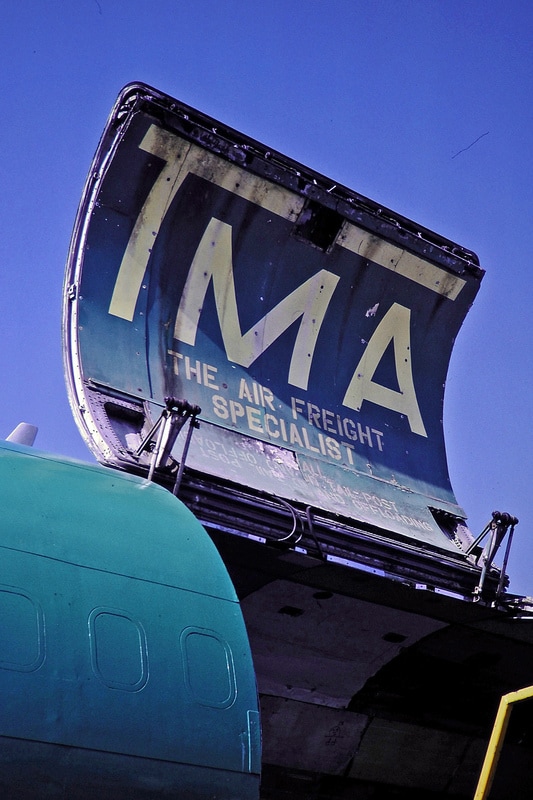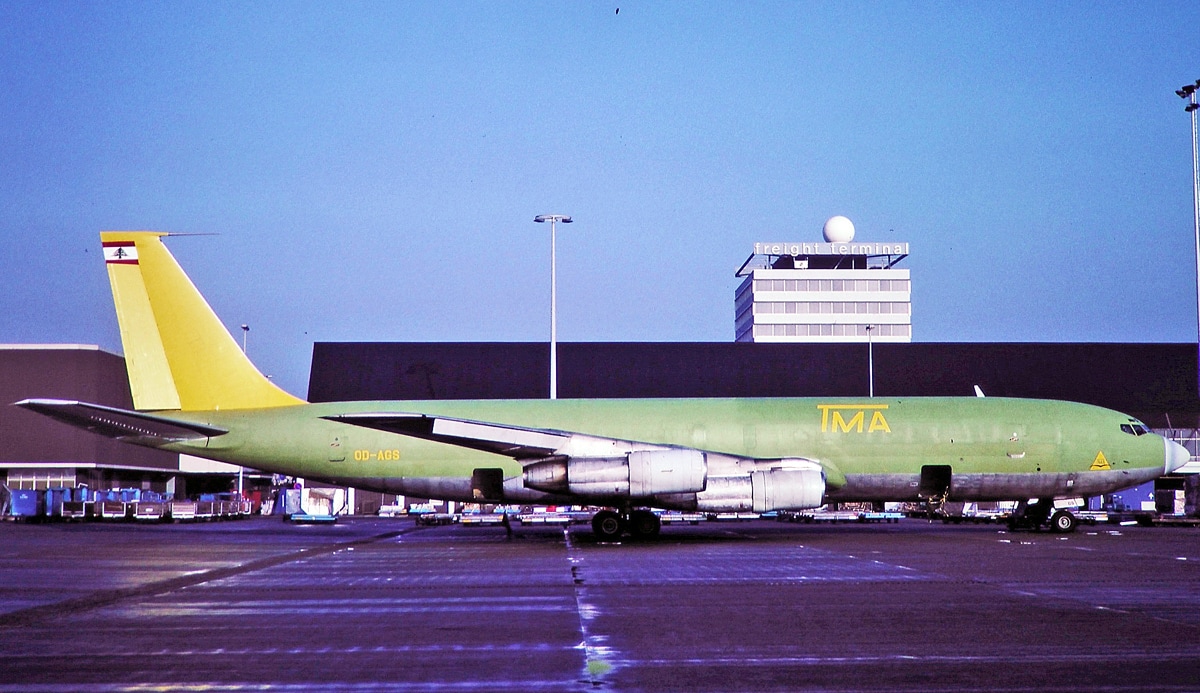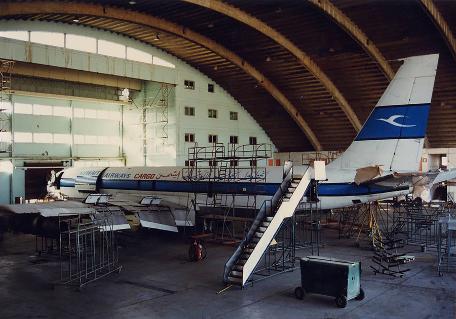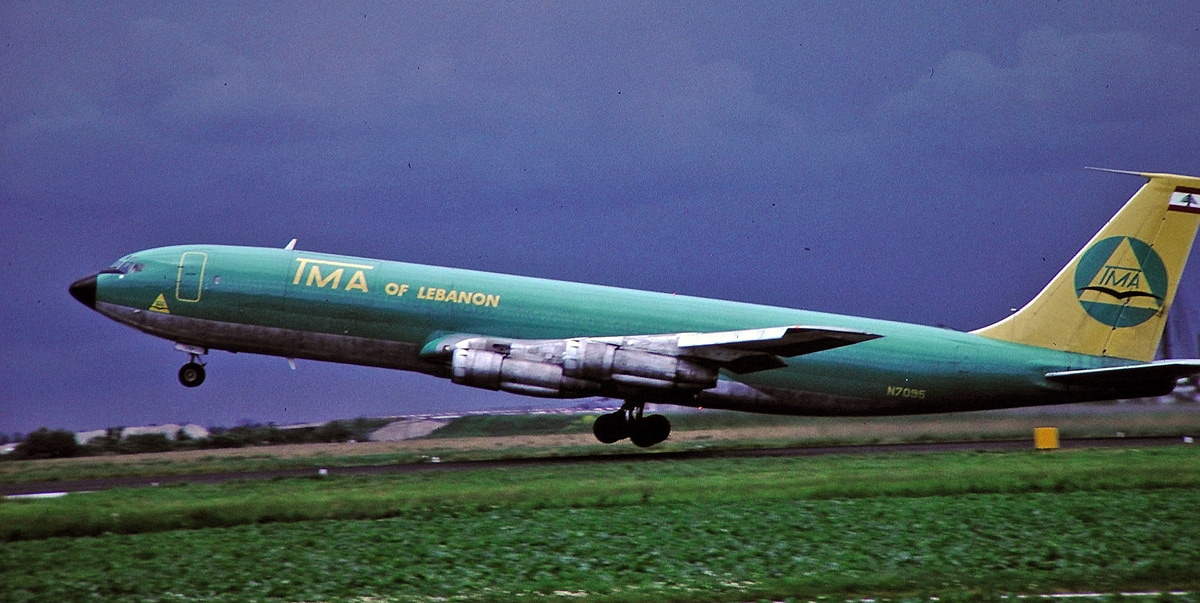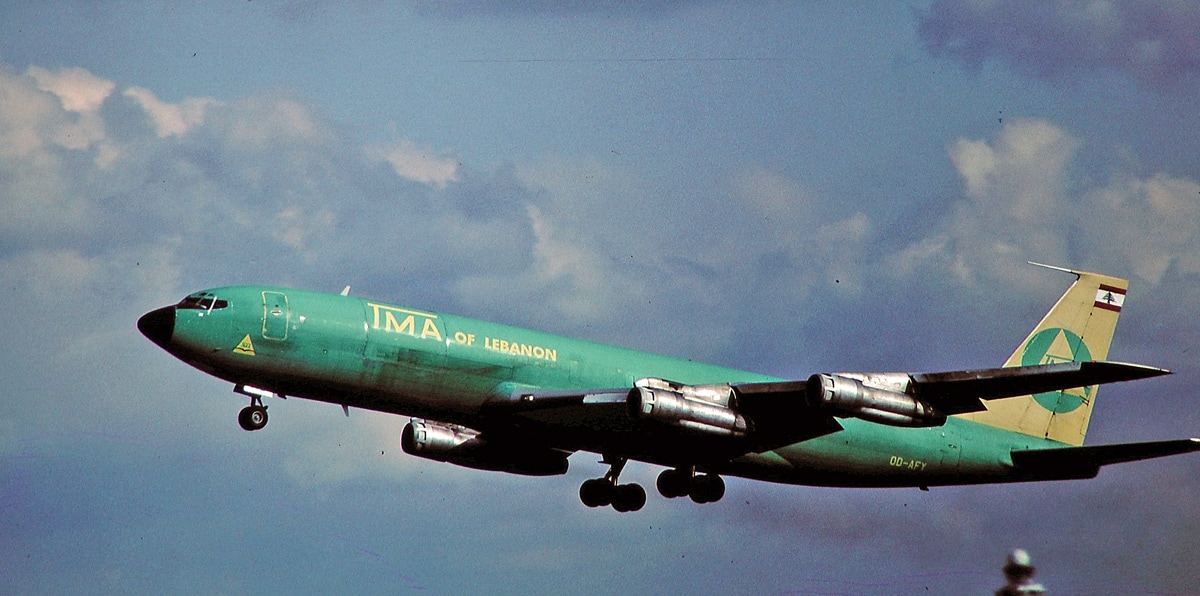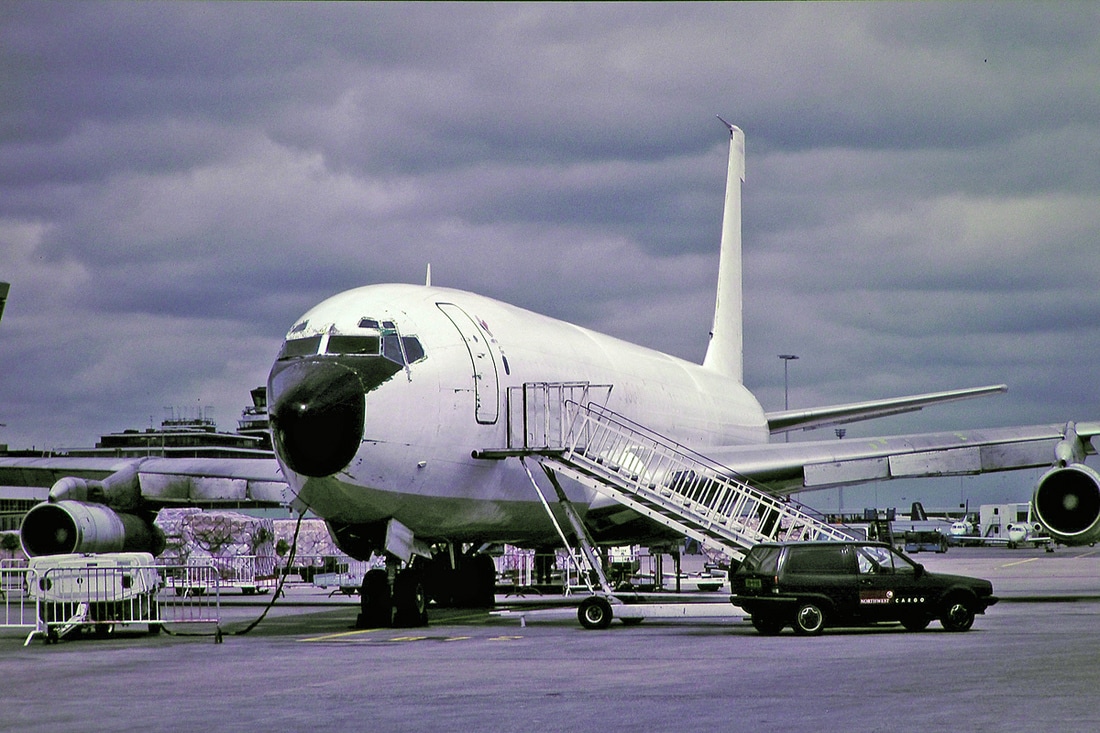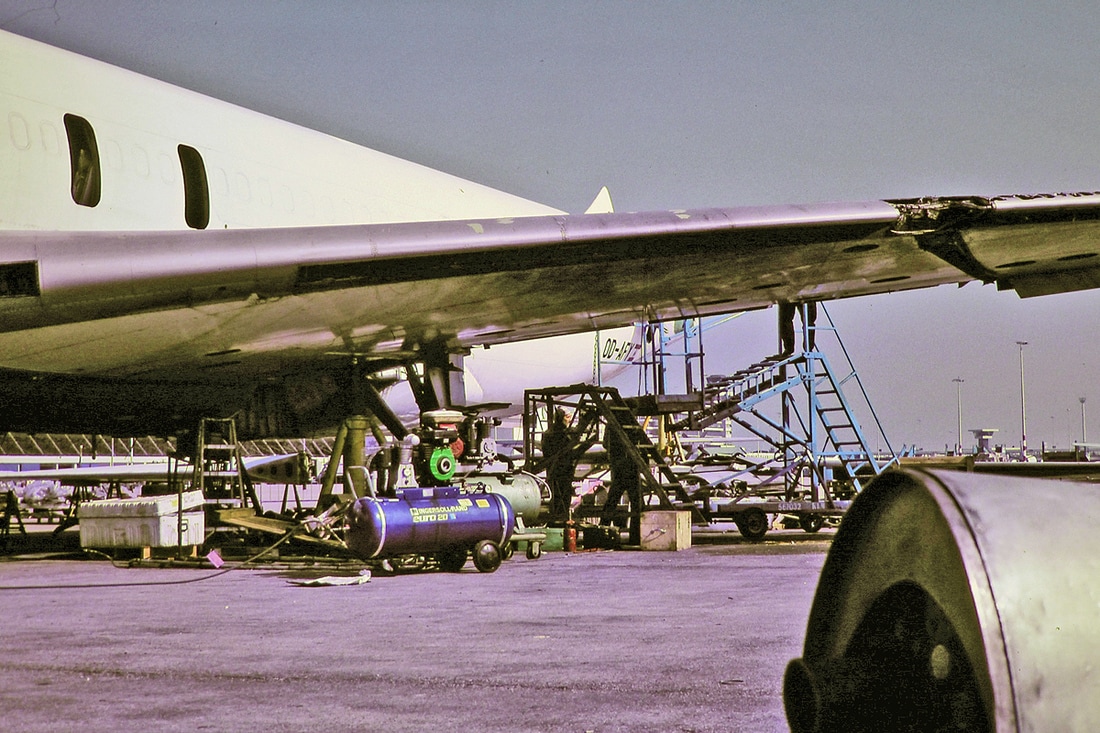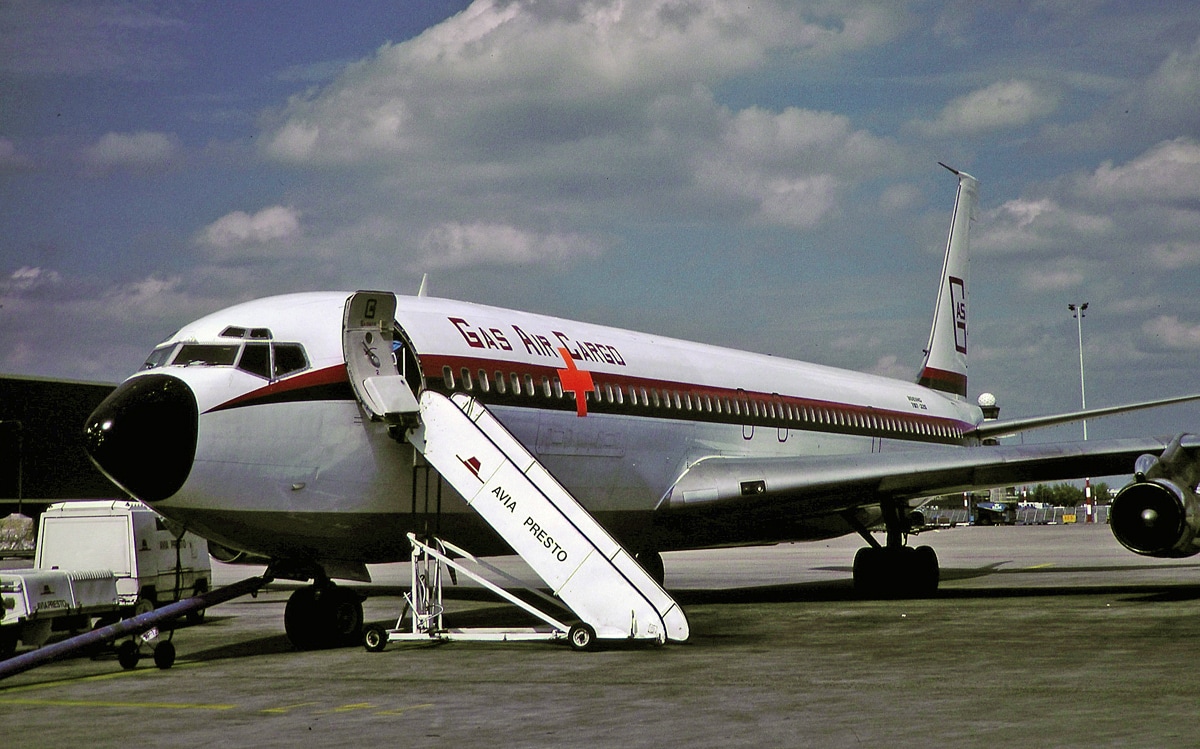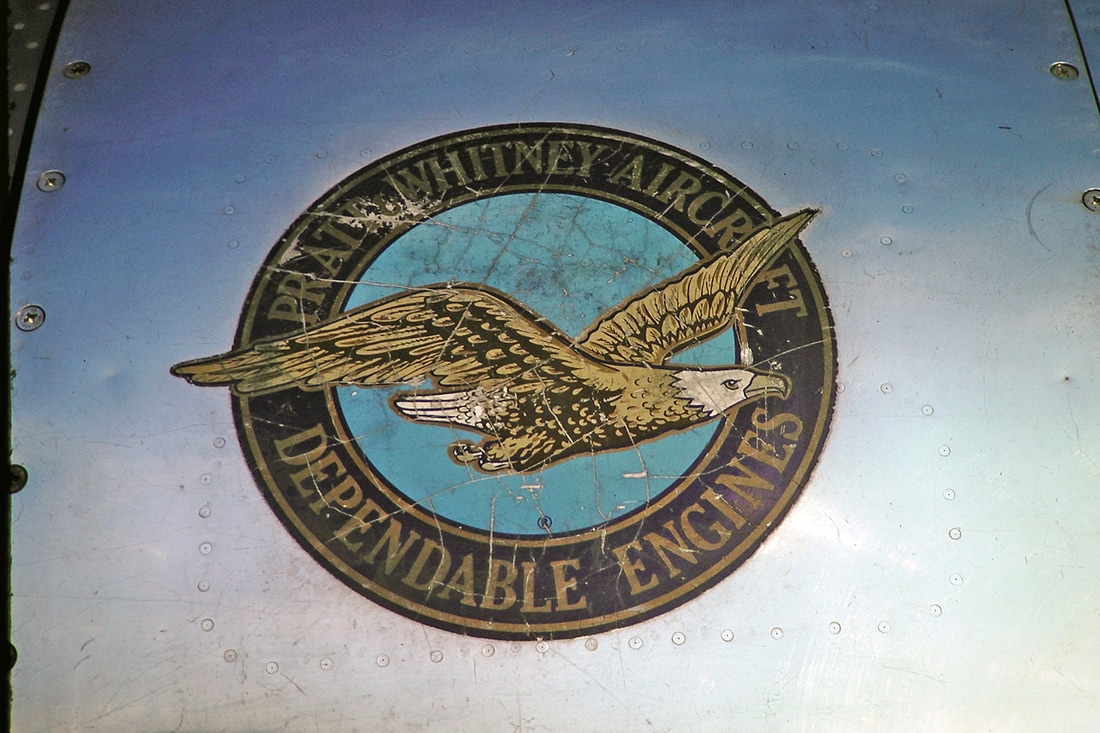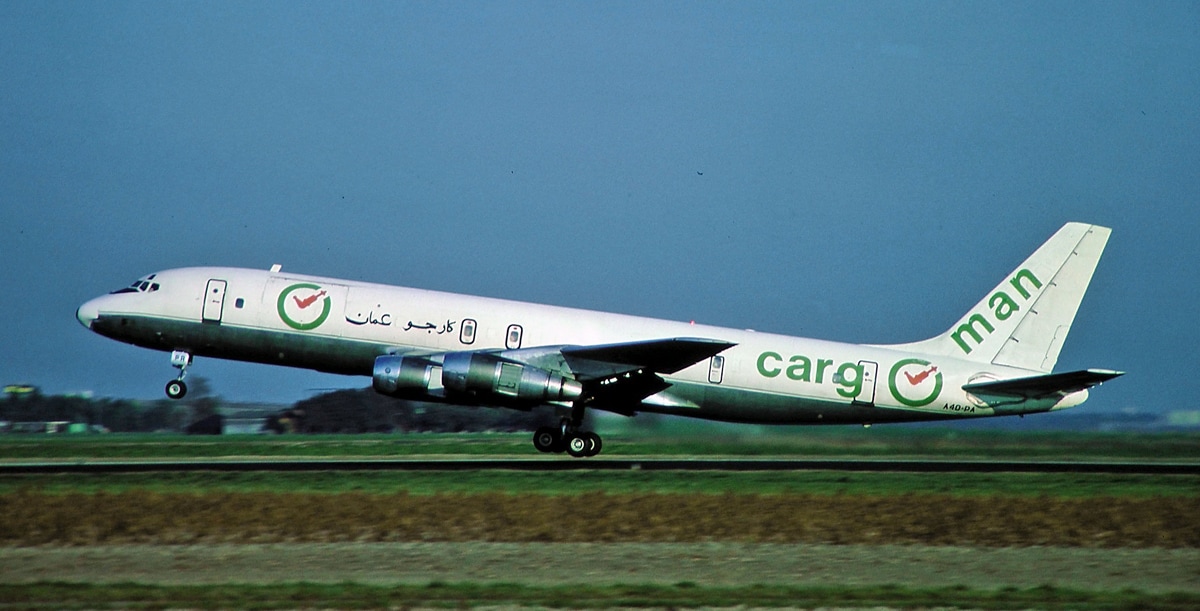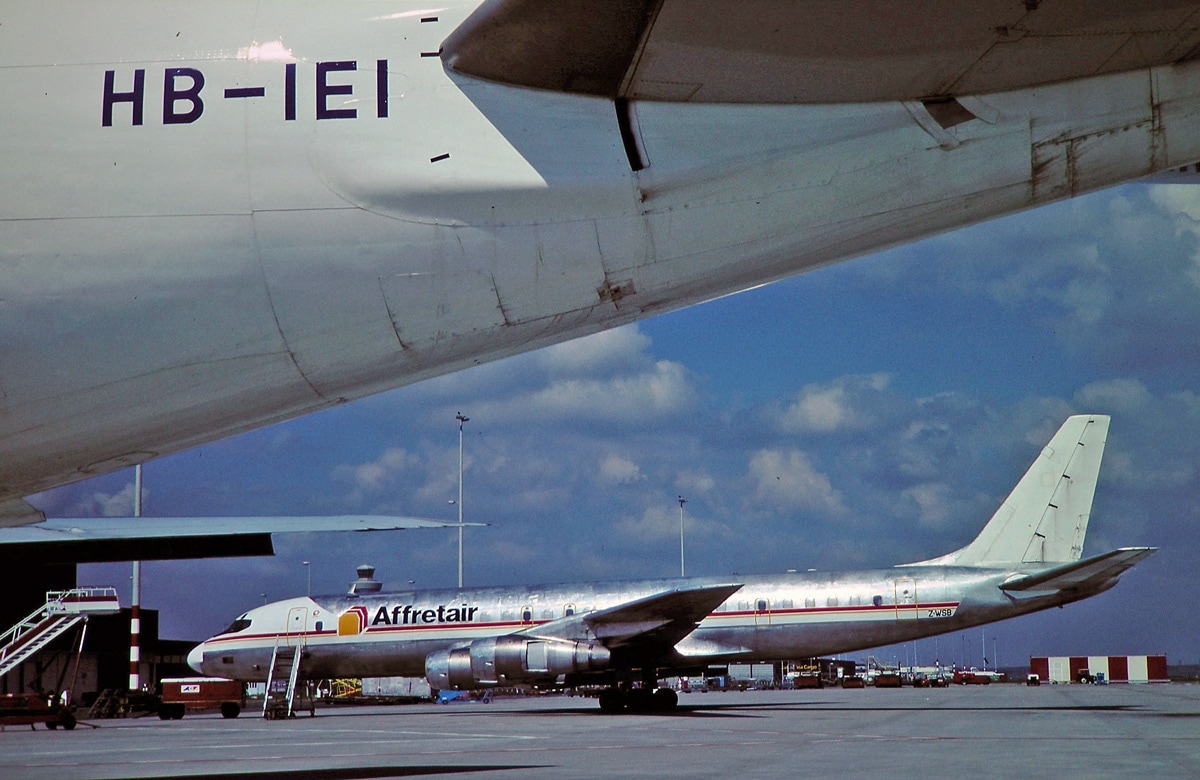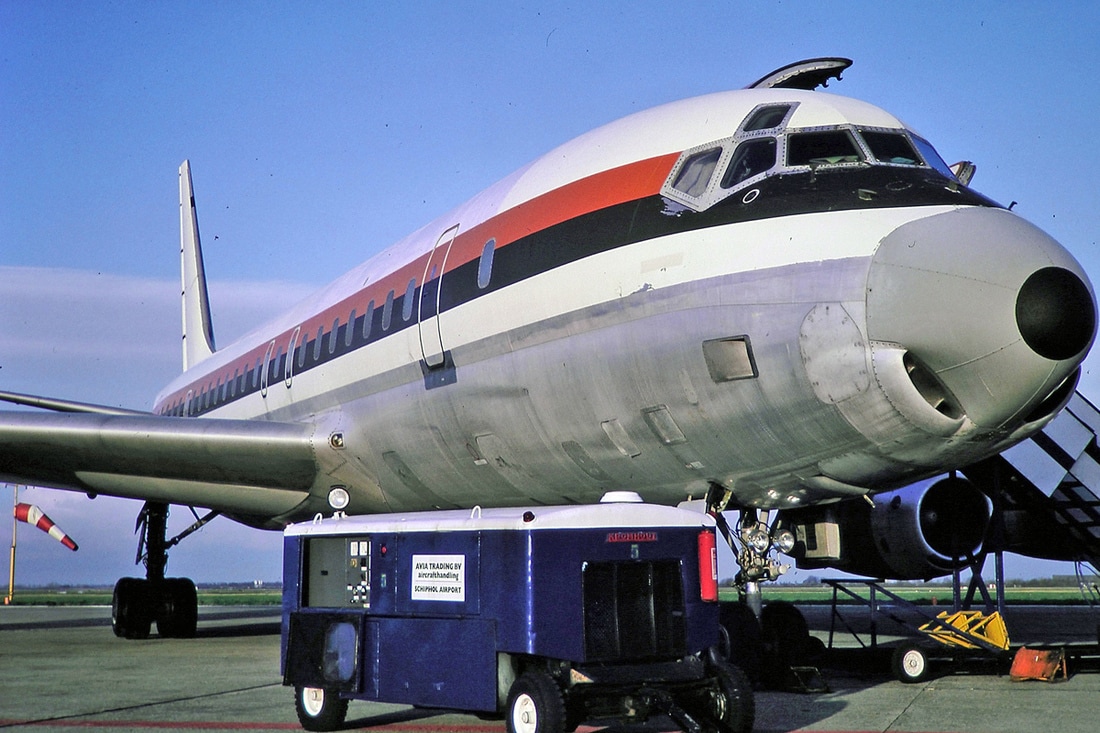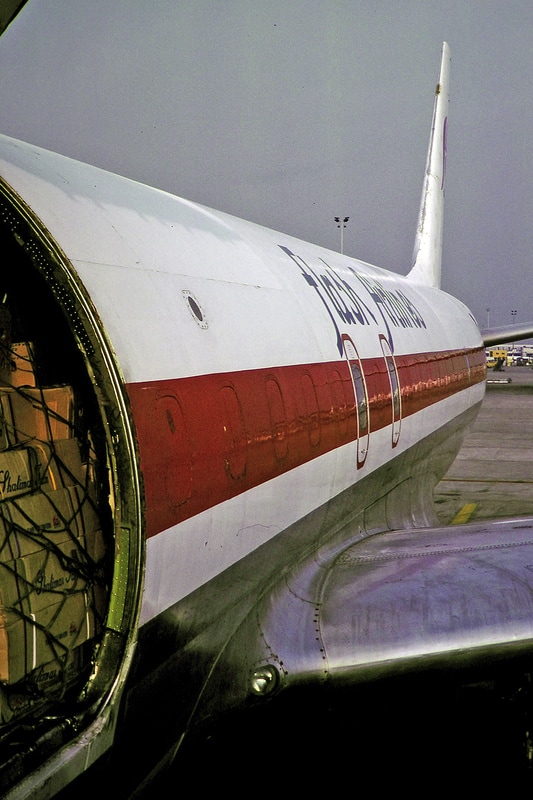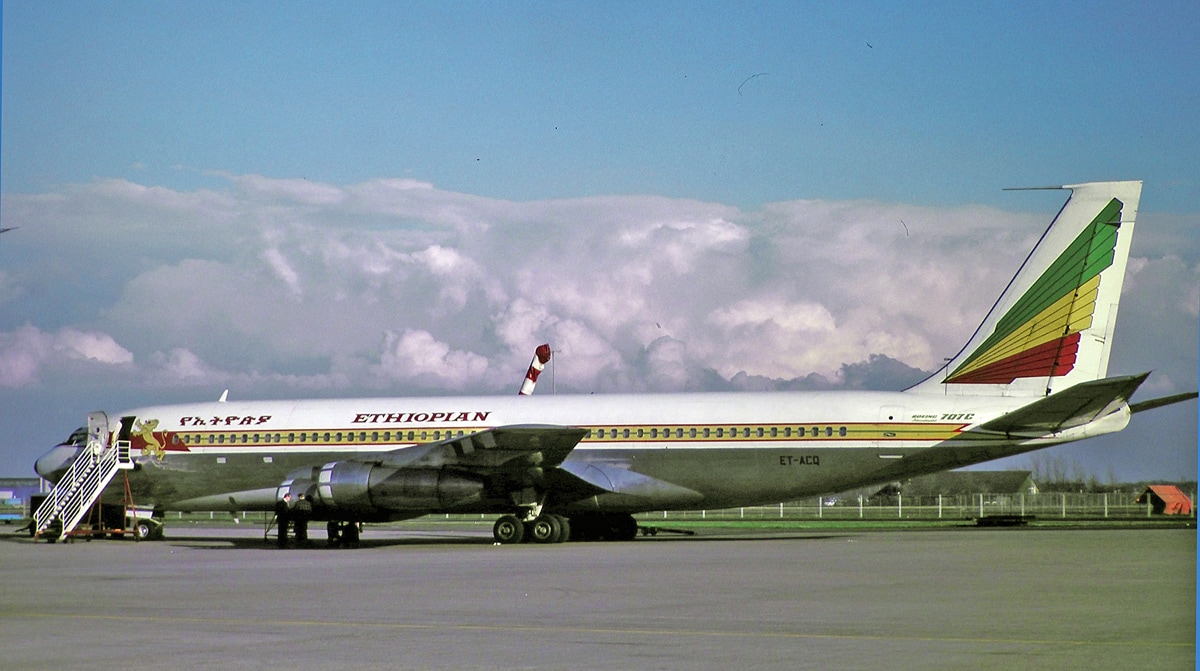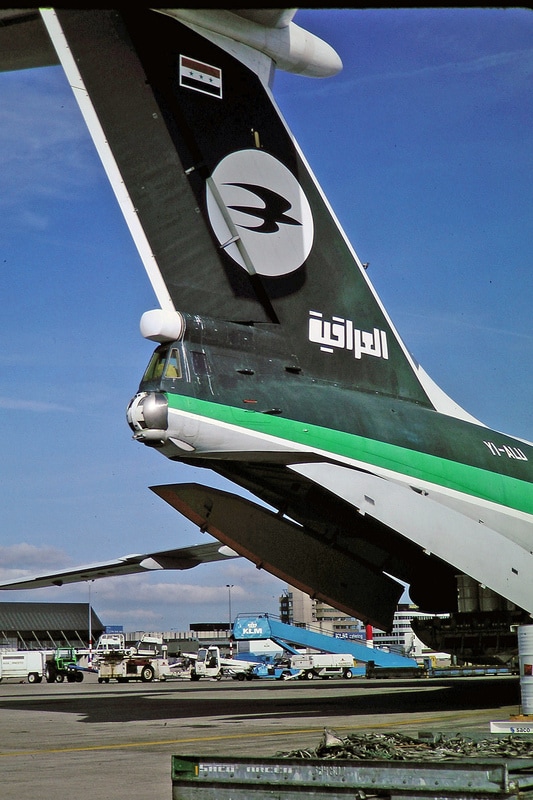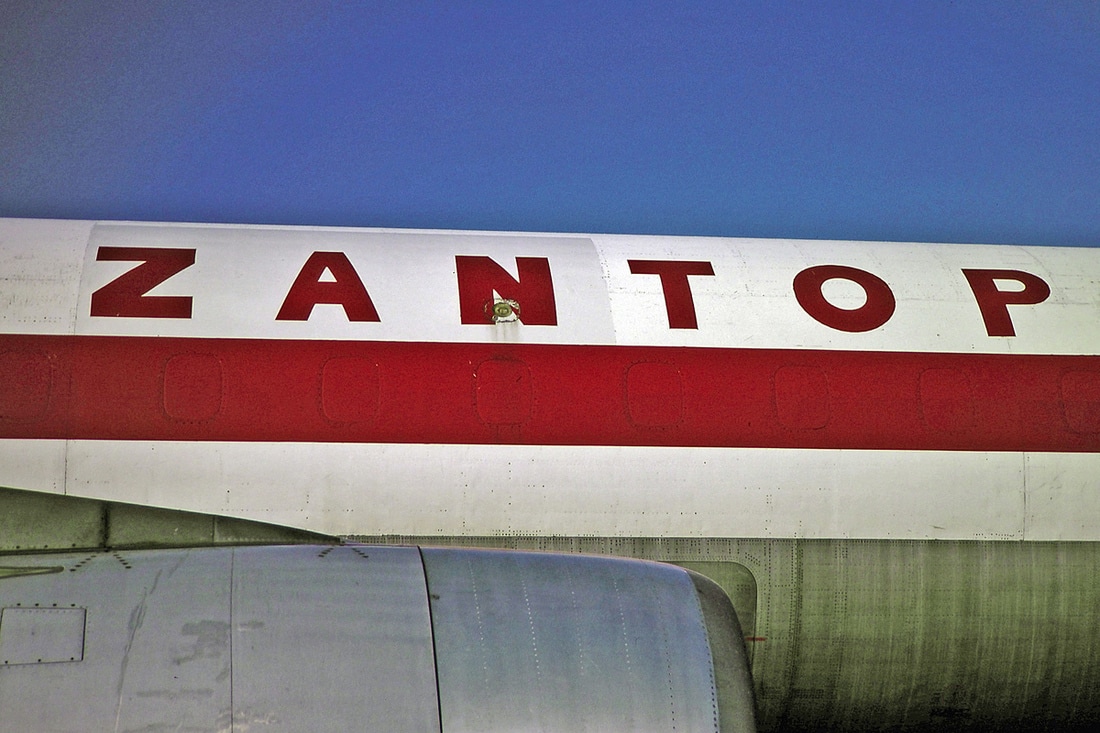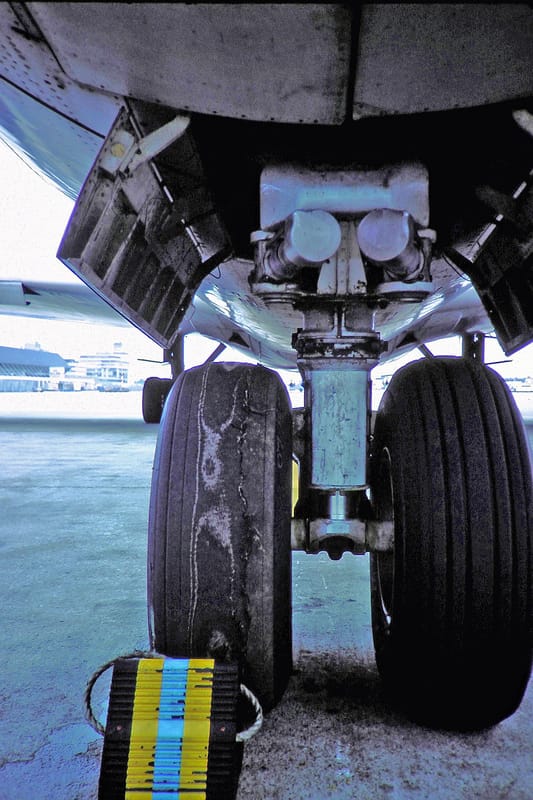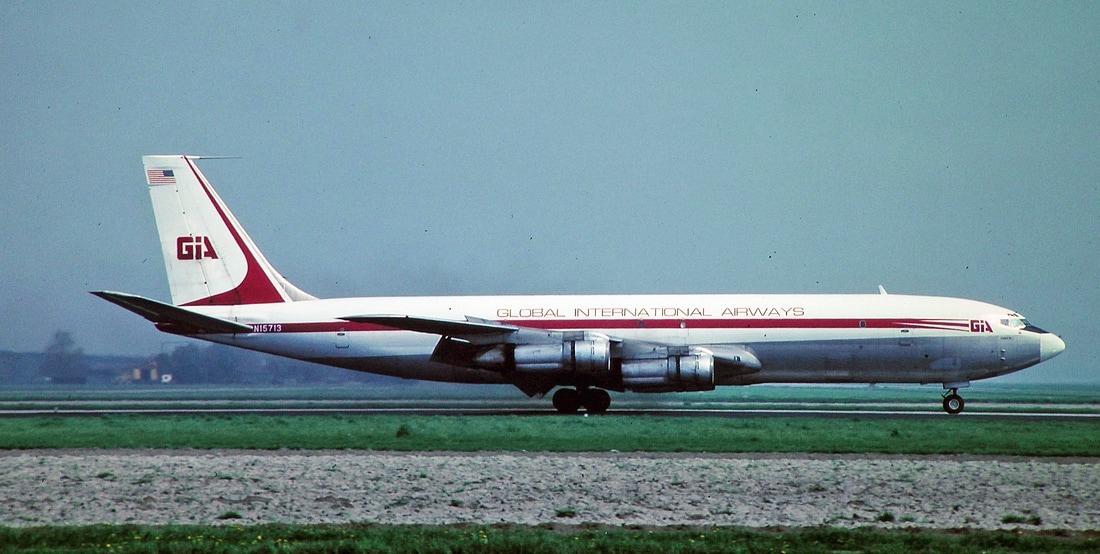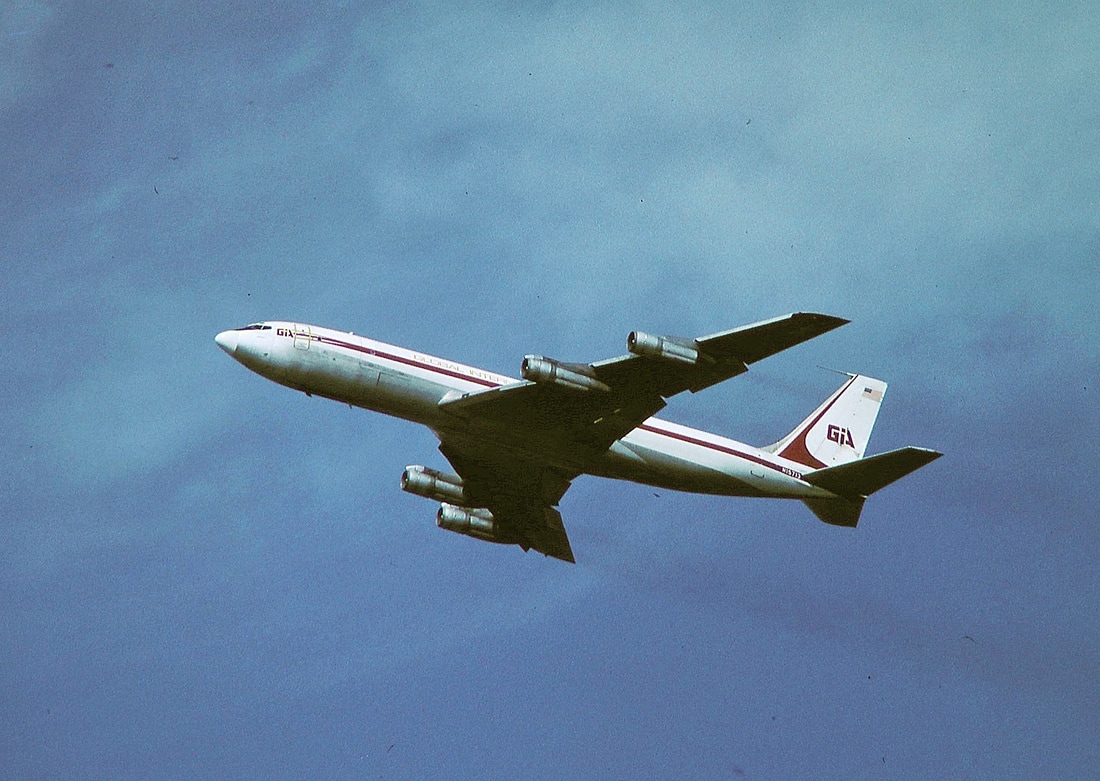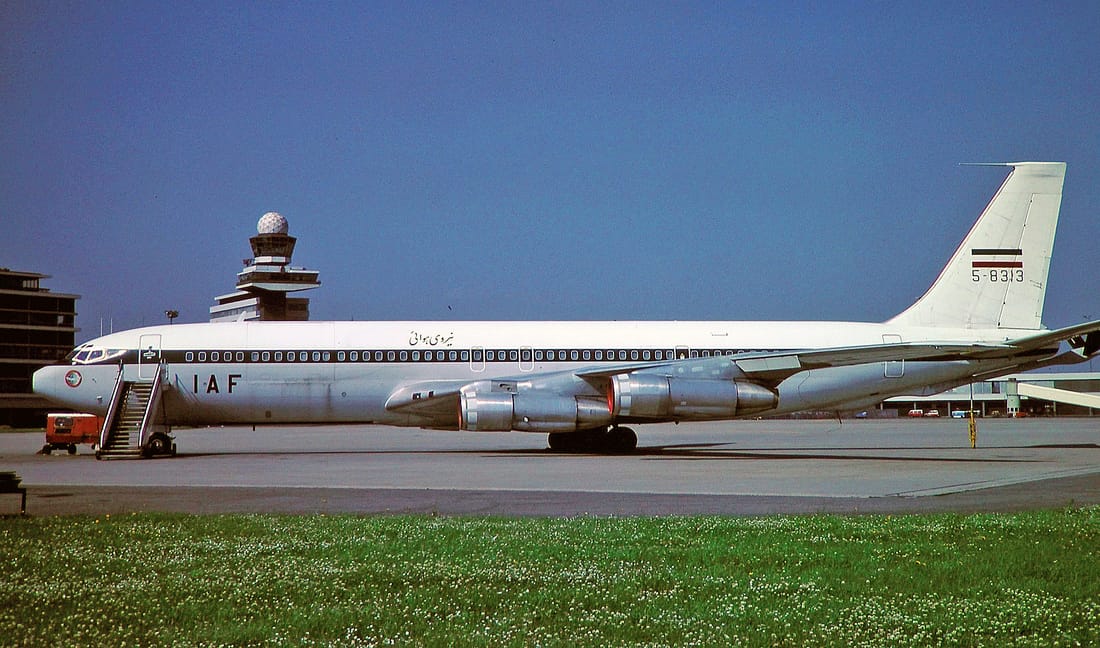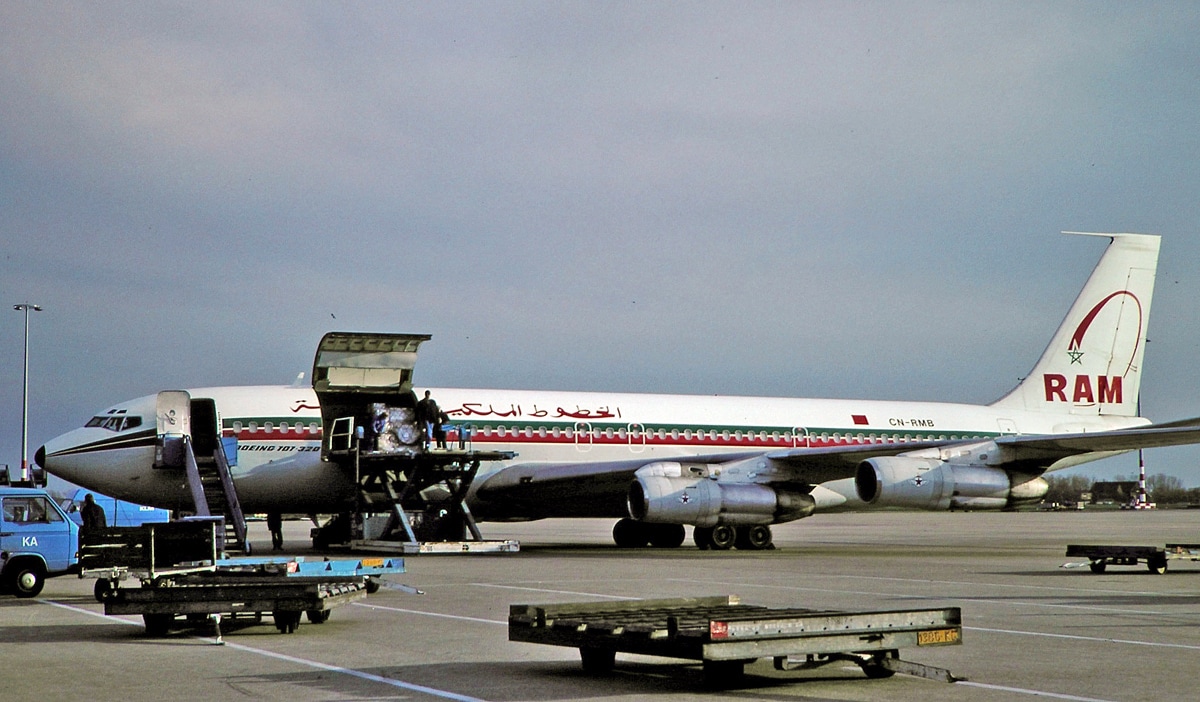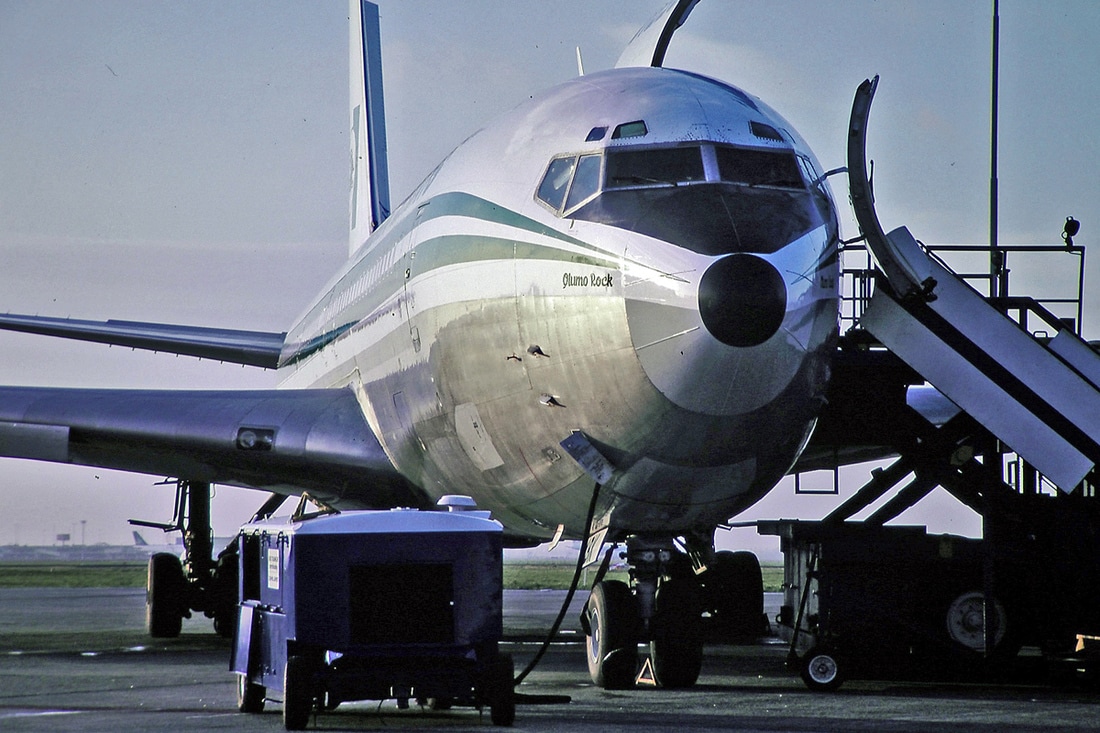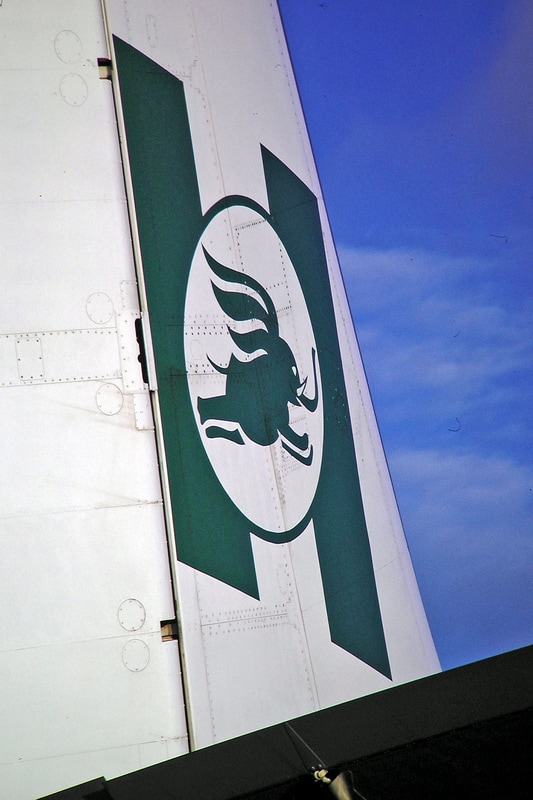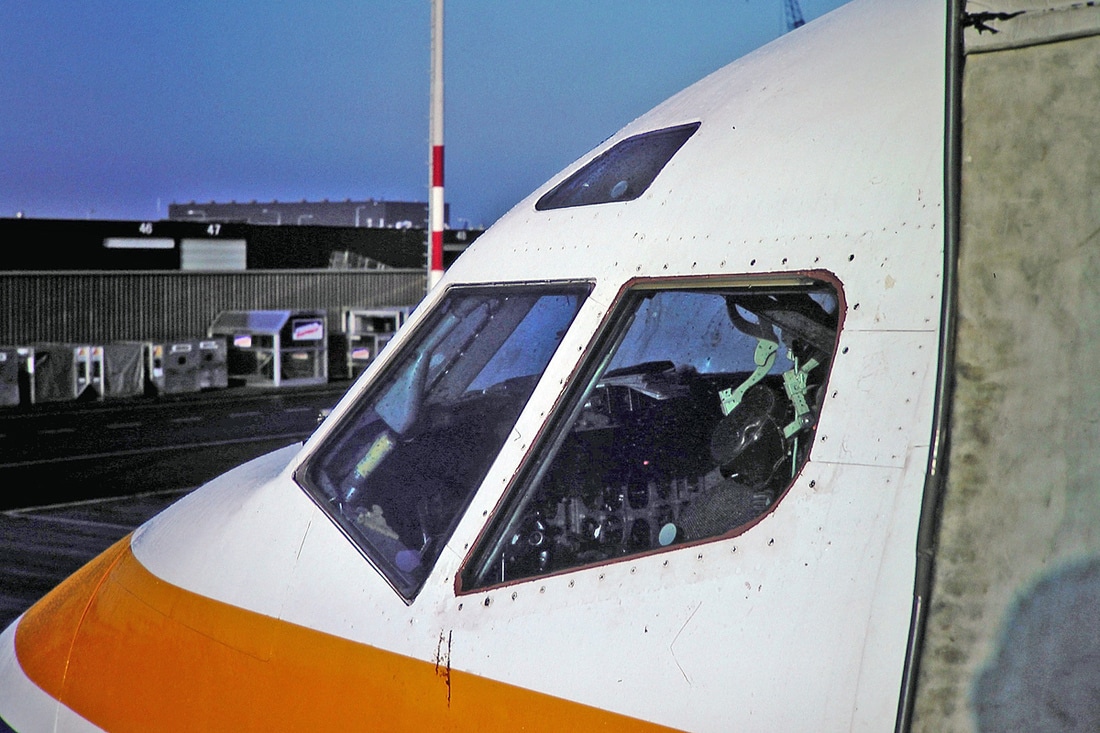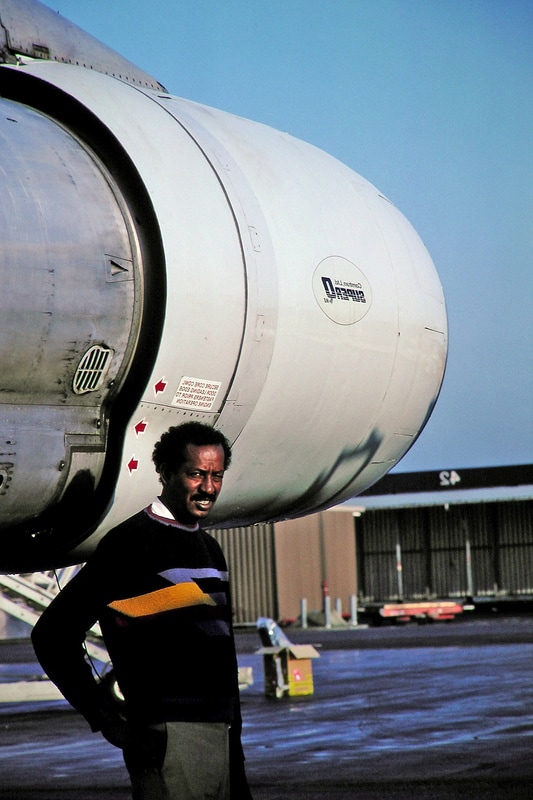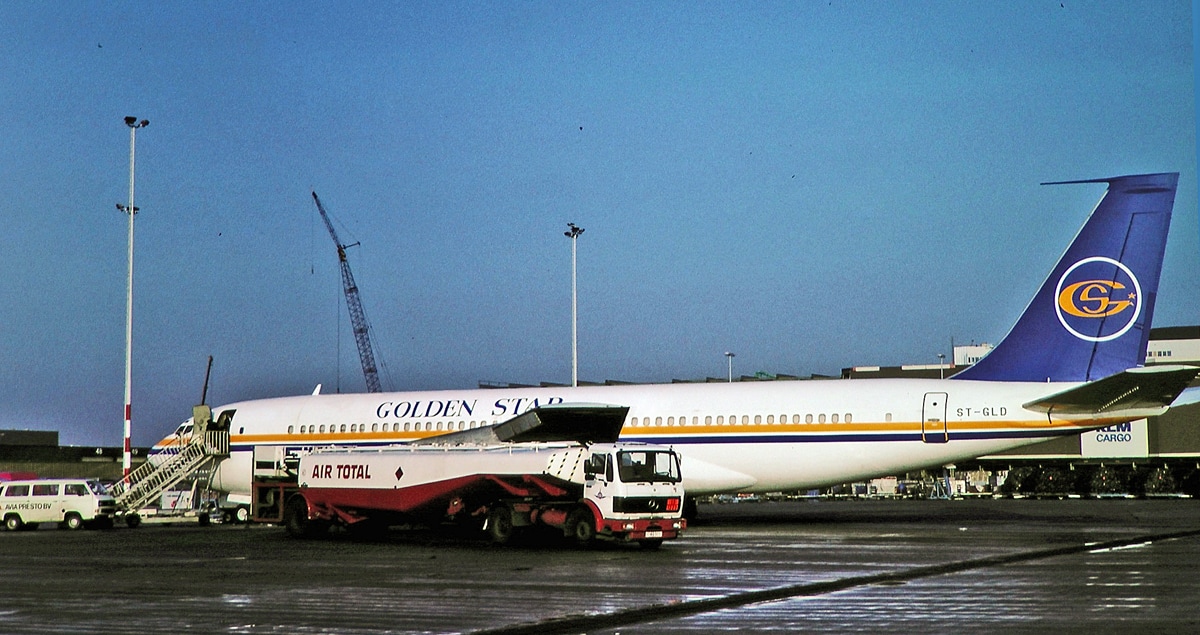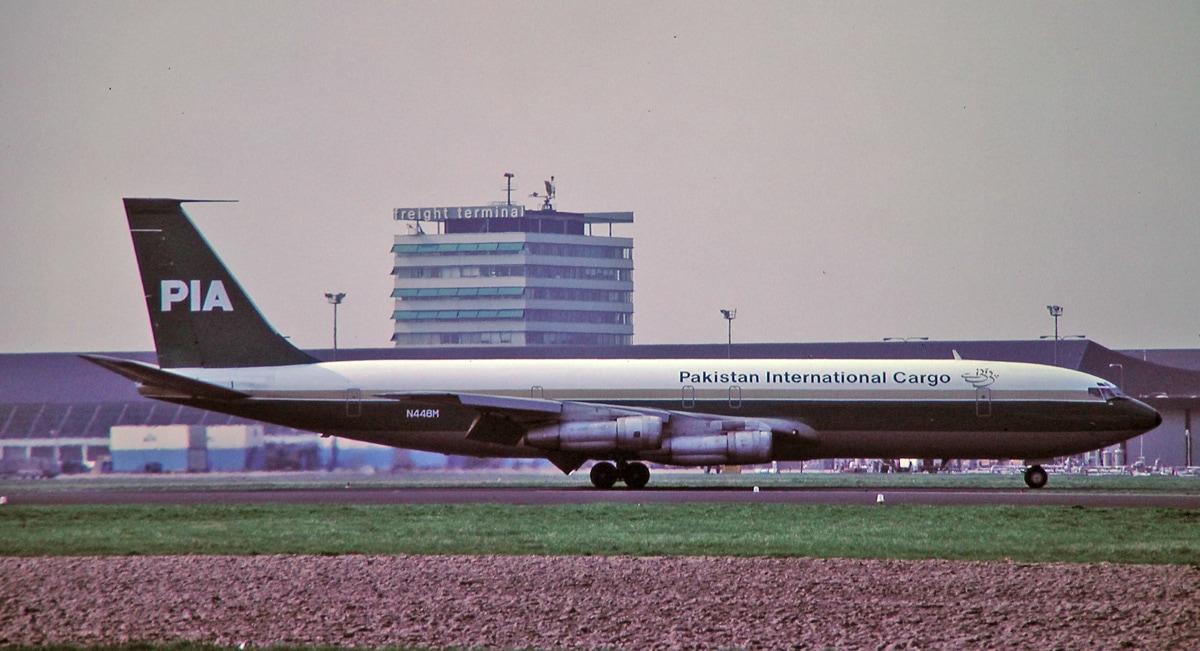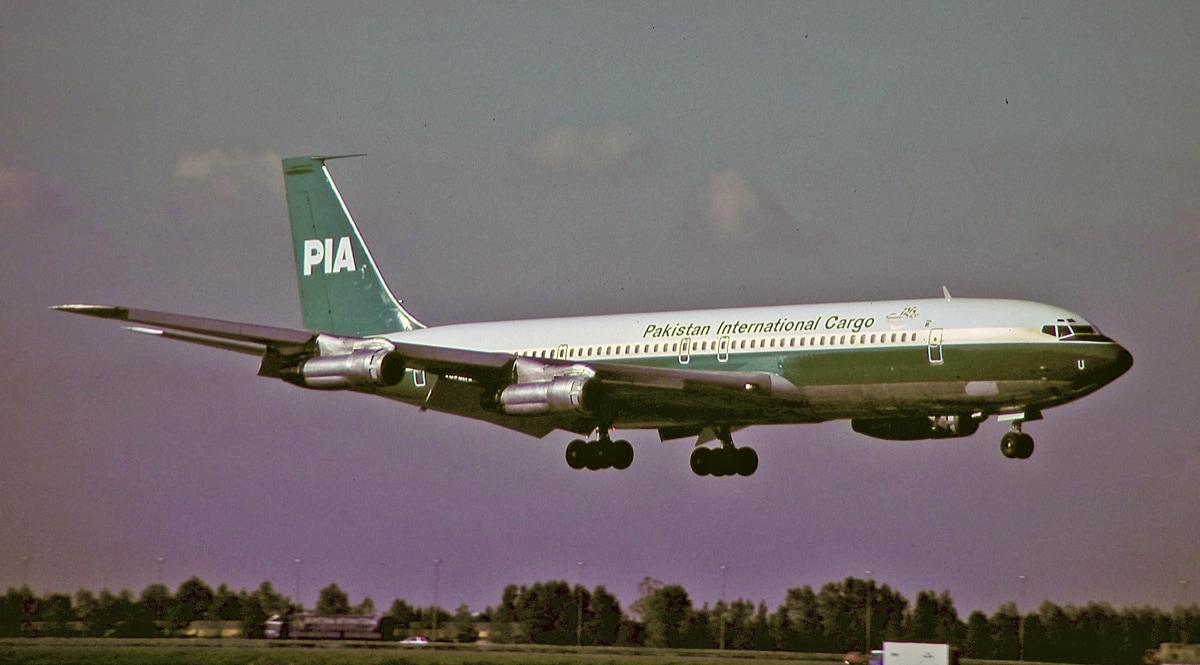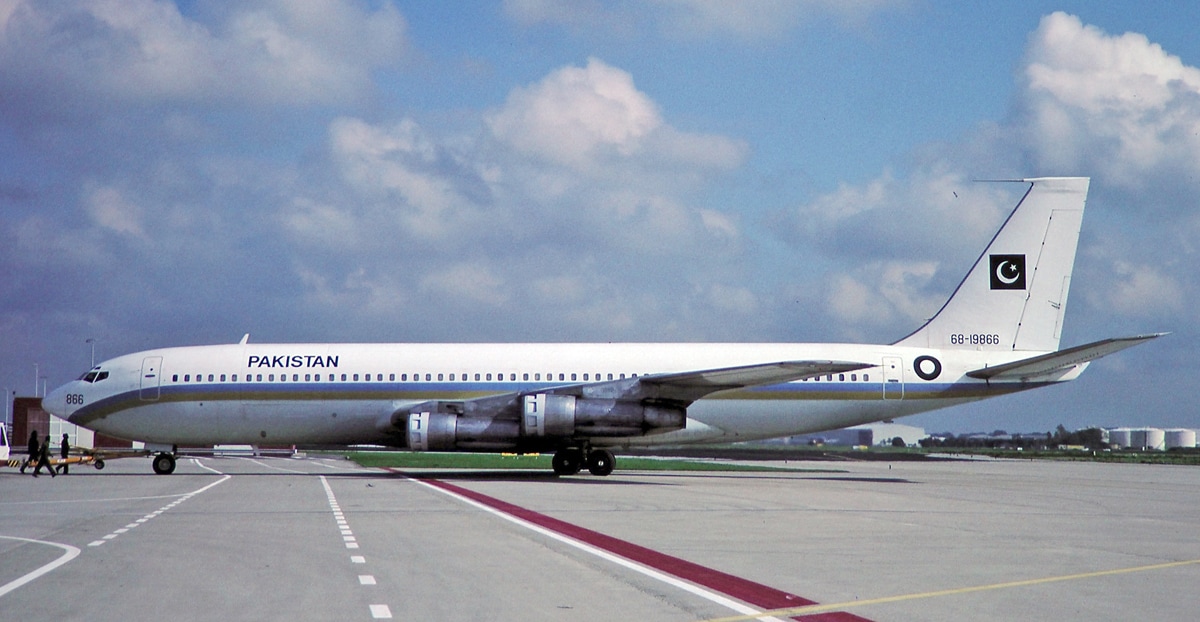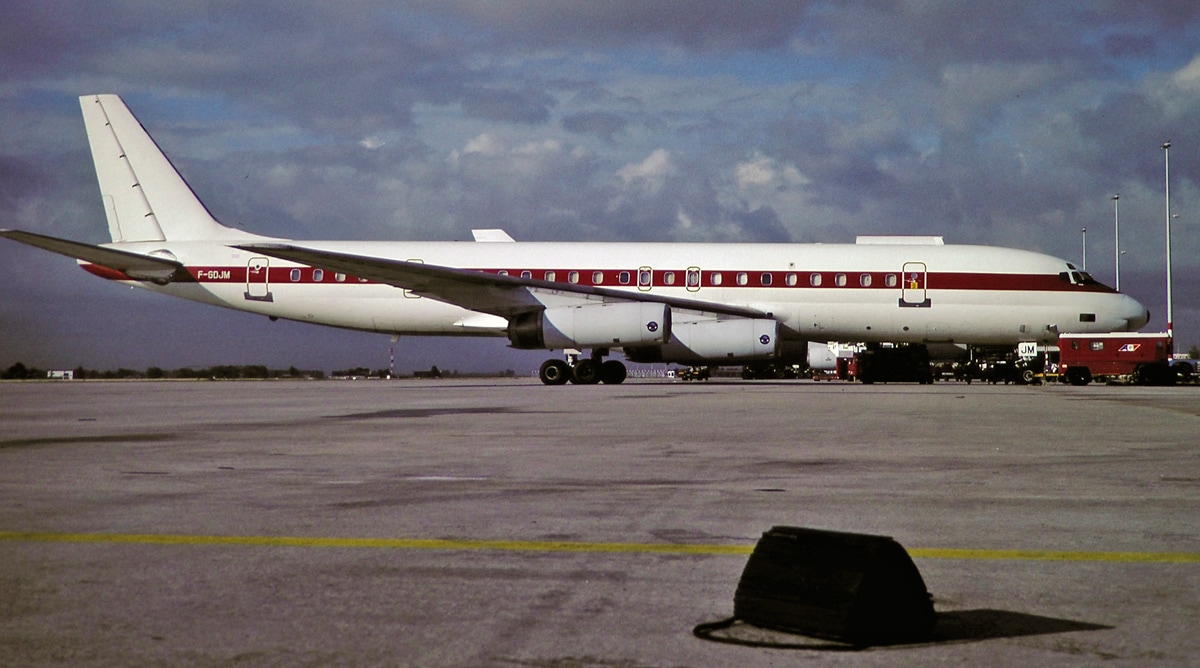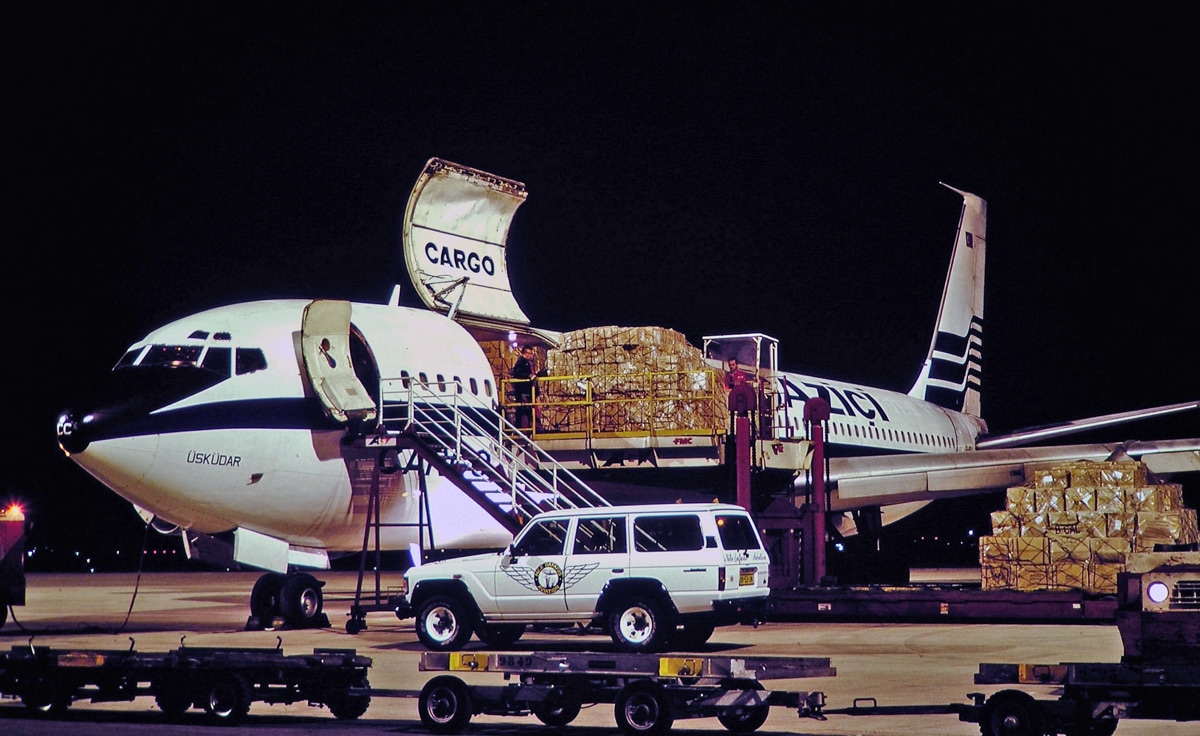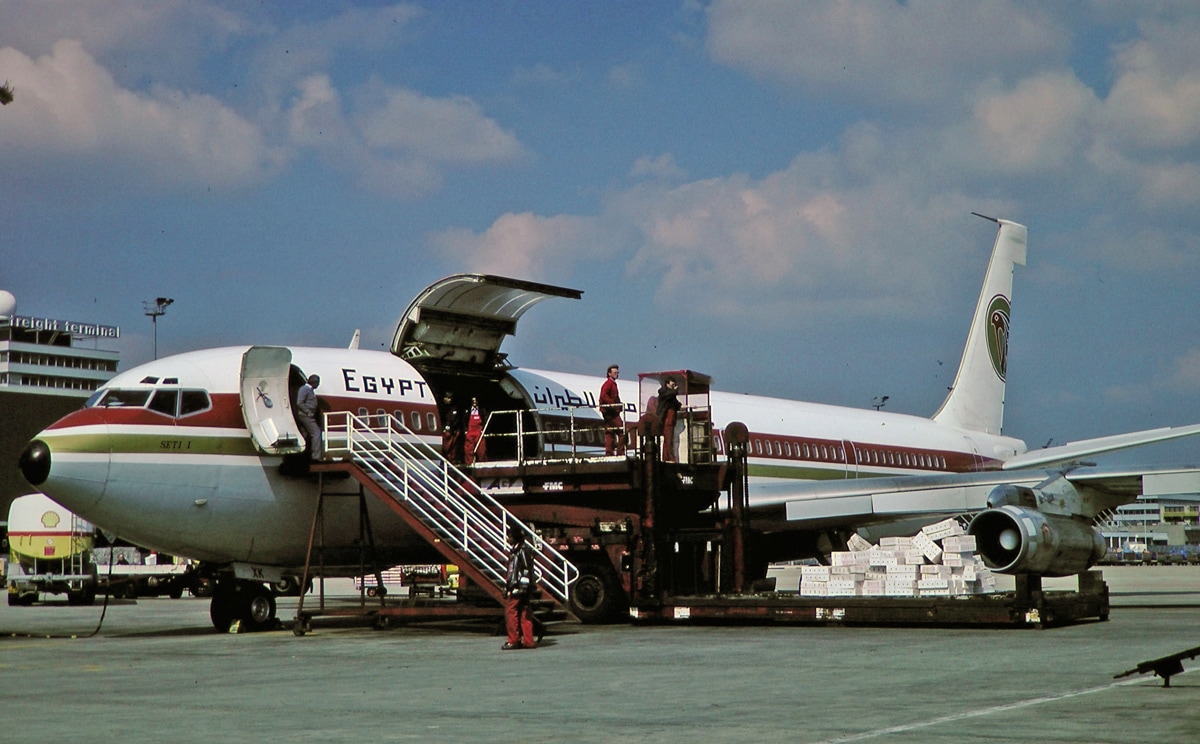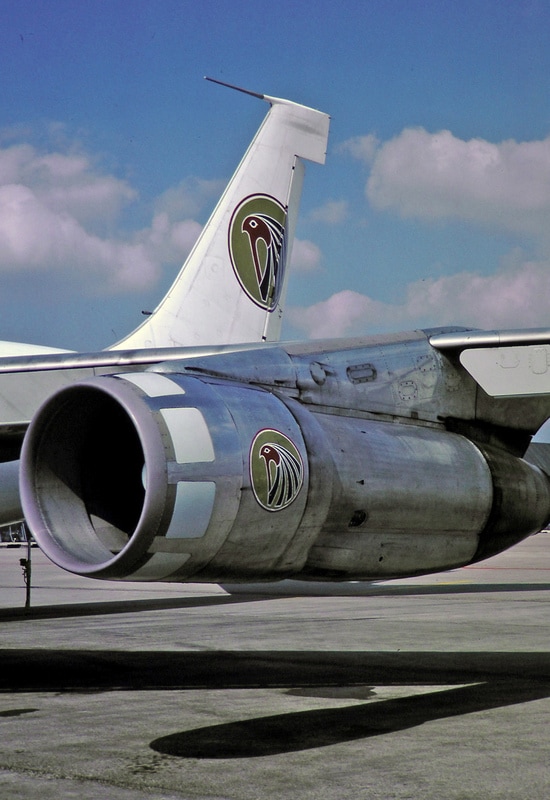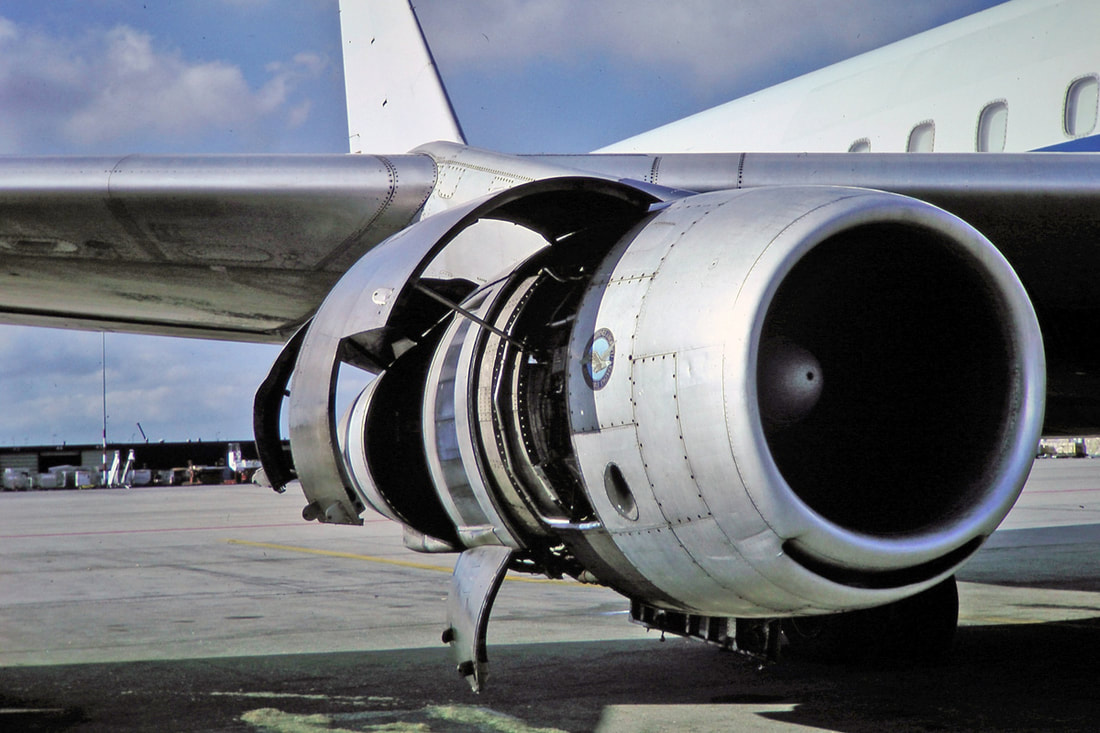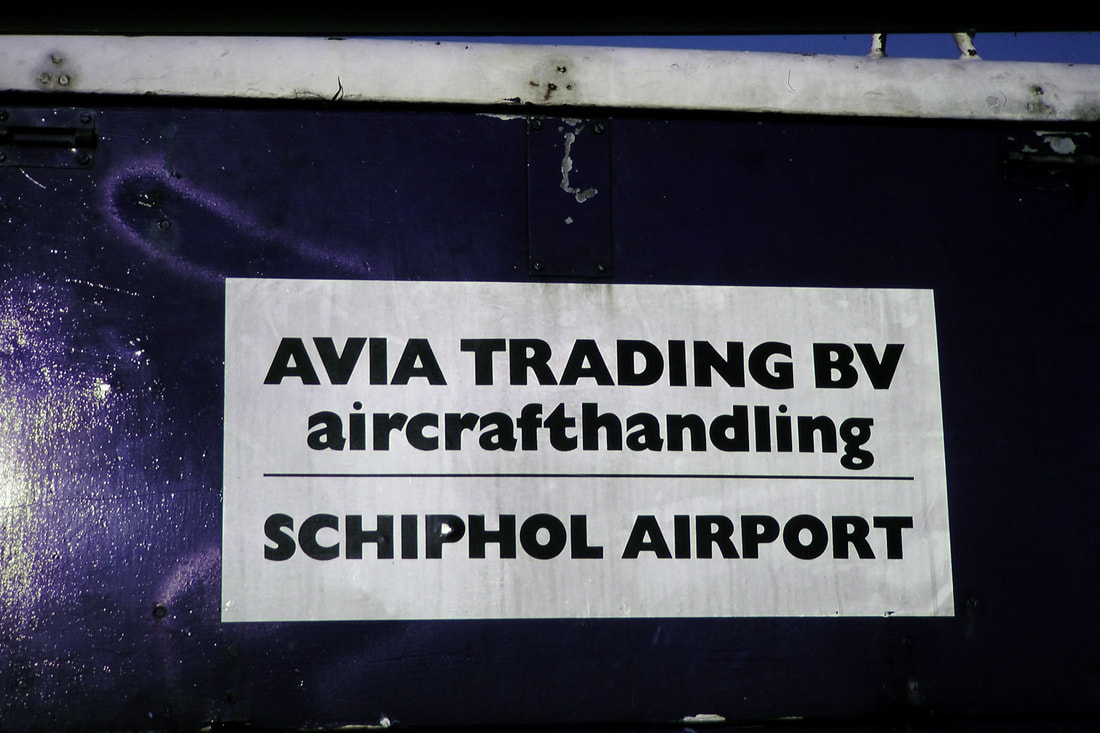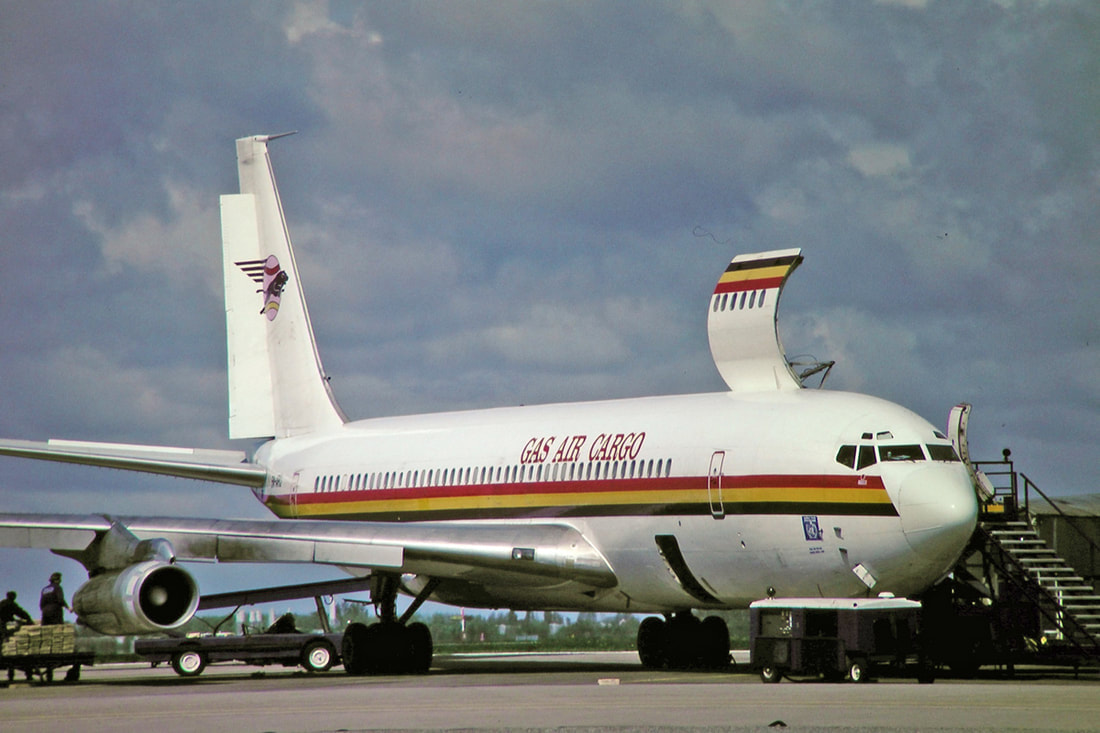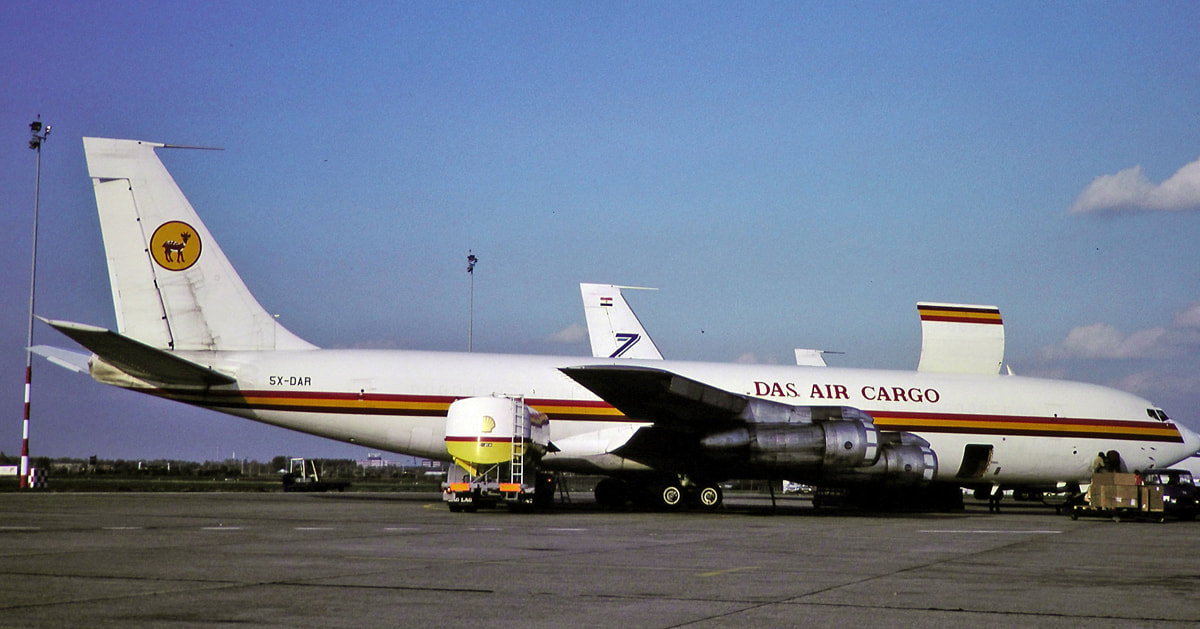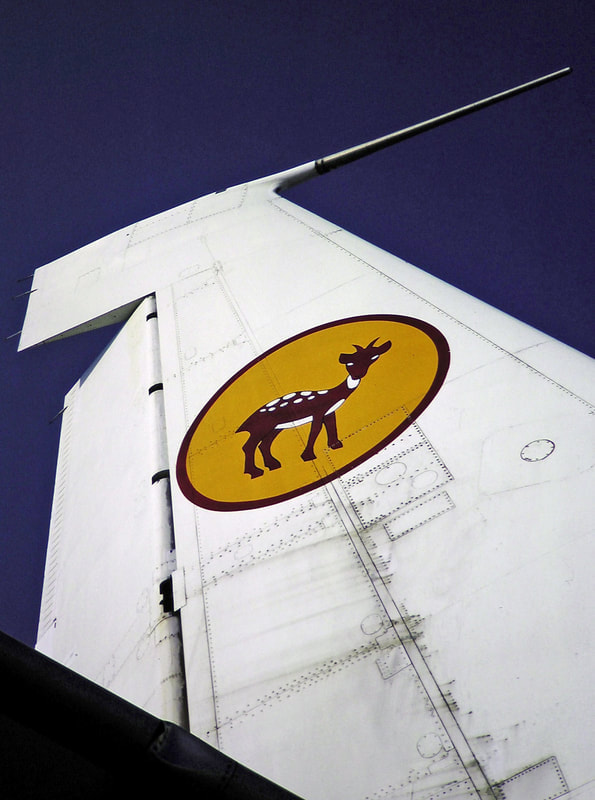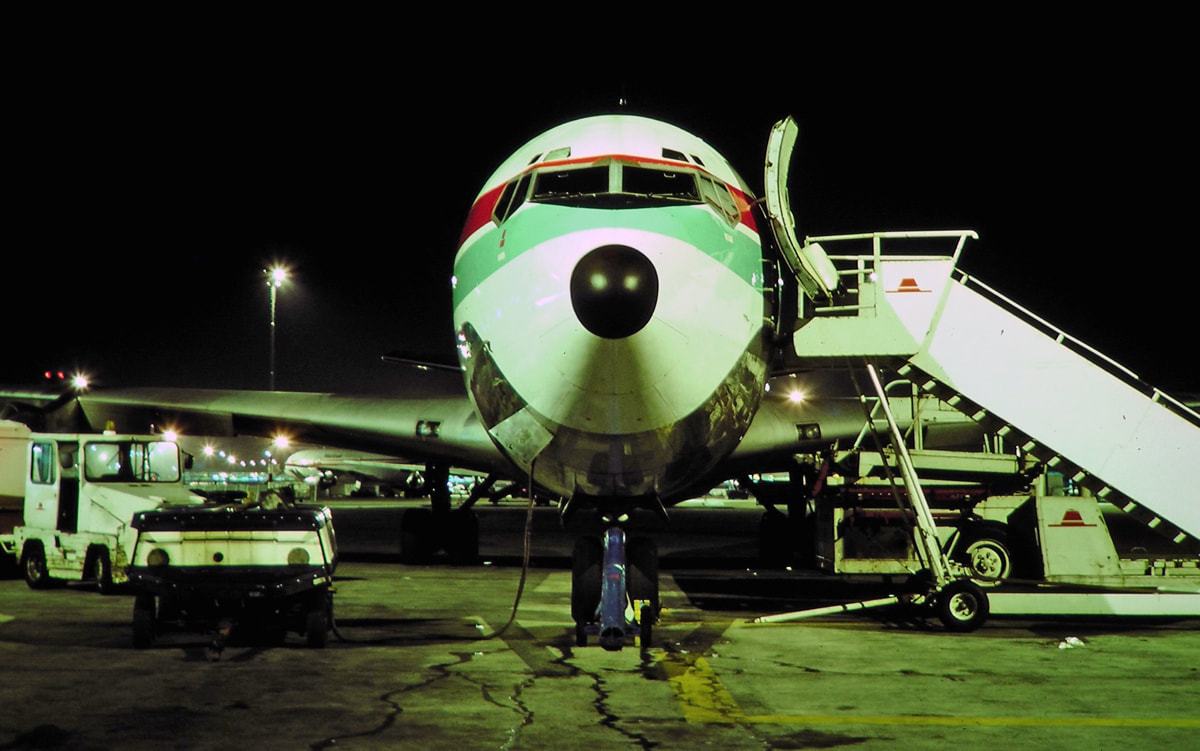Amsterdam OldJets |
|
|
Schiphol, well-known for its established carriers, was also frequently visited in the 80s by worldwide 707 and DC-8 operators such as; TAP Air Portugal, Iran Air, Ethiopian, Olympic, Bangladesh Biman, ELAL, Tarom, TMA and many more. Lesser known, but surely more interesting carriers graced the ramp at Schiphol, were the silver jets of Jet Cargo, Air Swazi Cargo, GAS Air Cargo, DAS Air Cargo, Zarkani, Arab Air Cargo, Misr Overseas, Seagreen, Okada Air, RACE Inc. and many more. This second category of freighters, often run by a couple of experienced aviators mostly on a low budget, will carry literally anything. Their cargo manifests shows, besides general cargo, such items as in-calf cows and one-day chickens, heading for exotic destinations such as Swaziland or Libya.
The 707 and DC-8, which could be acquired in the mid-80s at a reasonably low cost, offered a generous payload of 41,5 metric tons, which could be loaded on 13 pallets positions with additional belly-space. |
Besides these advantages there was a minor draw-back, in the shape of four fuel guzzling Pratt & Whitney JT3D-3B engines. Due to the downfall of the economy in the early 80s, the high level of fuel bills almost caused an early retirement for the 707, DC-8 and operators. Fortunately the late 80s fuel prices had dropped dramatically, which enabled the venerable 707 and DC-8 to operate profitably. Another problem was the upcoming noise restrictions in the 80s. Due to the increase of these restrictions at the major airport, the elder jets were to be banned for their excessive noise. Luckily hush-kitting brought the Oldjets comfortably within the restrictions and enabled these vintage jets to maintain a second career!
|
|
Trans Mediterranean Airways, styled as TMA Cargo (Arabic: الخطوط الجوية عبر المتوسط), was a cargo airline based in Beirut, Lebanon.
The airline was established and started operations in 1953 as a non-scheduled carrier operating cargo and passenger services. It was certified as the only Lebanese scheduled all-cargo carrier in 1959. It acquired its first Douglas DC-4 four-engine cargo aircraft in May 1959 and its first pressurized Douglas DC-6A freighter in March 1963. Trans Mediterranean Airways (TMA) was the first all-cargo carrier to establish round the world services in both directions. However the Lebanese crisis adversely affected TMA growth and operation. In November 1996, following the Lebanese "Horizon 2000" reconstruction plan, the airline took measures to modernise its operations, restructure activities and increase capital to around $40 million. TMA is owned by Lebanese Air Investment Holding. In 2002, TMA leased an Airbus A310-304F from Islandsflug during April to November, to operate their European routes as the Boeing 707's had been banned from Europe. TMA ceased all flights in February 2004 when the Lebanese Civil Aviation Authority (LCAA) pulled its Air Operating Certificate (AOC) citing safety concerns over its aging Boeing 707 fleet. The airline was in serious financial troubles and as a result was unable to modernize its fleet. In September 2005, there were reports that TMA was planning to relaunch operations with a renewed fleet by acquiring medium-haul freight aircraft to replace their grounded 707 fleet, small freighter aircraft for feeder routes, and two Boeing 747-200F aircraft for long-haul freighter flights to the far east, this never happened. In 2008, Mazen Bsat, Lebanese investor, owner and CEO of Med Airways (formally Flying Carpet), bought TMA for $1 in exchange of clearing the airlines $60 million debt. In October 2009, TMA launched renovated facilities and a new image, following this TMA also announced that they are to relaunch services. They acquired an Airbus A300-600F for the new cargo operations. In February 2010, the aircraft was painted in the new TMA Cargo livery. It suspended operations once again in September 2014. |
The airline restarted operations in 2010, following a six-year hiatus. It suspended operations once again in September 2014.
|
TMA Boeing 707-331C OD-AGS in a undercoat paint livery. Originally she flew for Trans World Airlines as N5773T, from 1967 until 1971. Being converted into a Freighter she operated world-wide scheduled cargo flights for Trans Mediterranean Airways as OD-AGS. During the early 90s she was leased to Kuwait Airways. As such she was a frequent visitor to Amsterdam - Schiphol airport. Unforetunately it was hard to find employment for a fuel guzzling 707 after the year 2000 and during 2001 she was stored at Beyrut next to the TMA hangar. She vanished from BEY after long term storage, probably scrapped.
OD-AGS takes a break between operations
|
One of the most obvious features of the 707 is the HF antenna on top of the fin. However, not all of them had them. Just about every -320B/C you'll see will have it, but there were quite a few 720/-120B's and such that didn't. It's roughly equivalent to whether it was an over-water plane or not.
|
Boeing 707 OD-AGS did operate cargo flights for Kuwait Cargo in the 80/early90's) I saw her during C/D-check at TMA maintenance at Beirut, Lebanon. On the left side we see Boeing 707 OD-AGP. March 10, 1993.
|
Boeing 707-327C OD-AGZ, which was manufactured in Novermber 1967 and enjoyed a long and various career. She started to operated for Braniff in the Americas. After hard working life with Braniff she was sold to TMA of Lebanon in August 1973 who converted her to a freighter. For seven years she remaind her original registration. In 1980 she was re-registration OD-AGZ. In May 1985 she was sold to Ethiopian, who registrated her ET-AIV. During April 1998 she was handed over to the Congo Government as 9Q-CGC. On April 14, 2000 she was damaged when a weapon-hold exploded. The 707 was dismantled by Hewa Boro May 2001. The fuselage was still relatively intact at Kinshasa during 2009.
Boeing 707-327C OD-AGW was manufactured in the autumn of 1966s and delivered new to Braniff International in February 1967. This Pratt & Withney JT3D powered 707 served the Dallas Love Field based airlines faithfully for 14 year. In February 1980 she was sold to TMA from Lebanon and her US registrated N7100 for the next nine years. In July 1980 she got her Lebanese registration OD-AGW. On 17 June 1981, Israeli warplanes began bombarding Beyrut airport and OD-AGW was damaged beyond economical repair.
This one-time Braniff International Airways Boeing 707-327C (327 was the unique, fixed Boeing customer code of Braniff) rolled off the production line in 1966 and was delivered to her proud owner as N7095. In 1971 she was sold to Trans Mediterranean Airways but remained her registrated N7095 for the remaining nine years. In 1980 she was re-registrated OD-AGX. Between October 1992 until including January 1994 the Boeing was lease to Kuwait Airways .
The same aircraft but now with her Lebanese registration OD-AGX. Between October 1992 until including January 1994 the Boeing was lease to Kuwait Airways and Air Afrique. In February 2002 she was withdrawn from use and during the following years she was slowly dismantled.
Boeing 707-327C OD-AFY, climbing after a Schiphol runway 24 takeoff
OD-AFY was powered by four hush-kitted Pratt & Whitney JT3D-3B (HK). Those engines were delivering 18,000 lbf (80.07 kN) thrust
TMA Cargo Boeing 707-327C OD-AFY. The last action of this plane was on Monday, July 26, 1993. When taxing out to the runway at Amsterdam Schiphol, as flight TL172 for Beirut, the crew heard a loud bang. They taxied back to the stand and major damage was found at the wing primary structure. The trunnion support beam for the right main gear failed, most probably caused by long term corrosion and associated metal fatigue.
Note; - Our worn-out VW polo Northwest Cargo company car next to the stairs. When working at Northwest Airlines during May 1992 and November 1993, as their Amsterdam based Cargo Agent, I could freely roam around the platforms!
Note; - Our worn-out VW polo Northwest Cargo company car next to the stairs. When working at Northwest Airlines during May 1992 and November 1993, as their Amsterdam based Cargo Agent, I could freely roam around the platforms!
The real green TMA colors are fighting their way back
Unfortunately service life was running out for this hard working 707 and during the passing weeks she was parted-out and scrapped
|
During August 1993 OD-AFY was parted-out and scrapped at Amsterdam Schiphol. Her cockpit was saved and bought by a scrap-dealer. Several years later the cockpit was transported to Beneden-Leeuwen Harbour on September 23, 2005 to be sunk off in Beldert lake as a diving object.
Note; - Your author in the cockpit while the tail-end was being scrapped! |
|
TMA of Lebanon closure
TO WHOM IT MAY CONCERN Date : 30 October 2014 With regret we like to inform you that Trans Mediterranean Airways ( TMA ) of Lebanon will cease its worldwide operation as per immediate effect. For many concerned this unexpected news may still come as a surprise. Old-timers will remember that TMA has been operating for nearly 50 years into the Netherlands and started its cargo flights in 1963 on the sector Beirut- Schiphol-Beirut with DC-4 and DC-6 prop liner freighters. We were among the oldest cargo carriers and pioneers at Schiphol! The end of an era Our holding management in Lebanon however , has decided not to continue its operation. The reason for this comes from various angles and perspectives, economical and political. Our business from Europe endured an increasingly growth over the last four years. On the other hand, the support markets in and from the Middle East declined during this same period. With narrow margins now days, any cargo airlines cannot afford such unbalance anymore. As you have noticed in the Middle East there are substantial political, religious and ethnical problems. The daily news is sometimes confronting and depressive and it is not encouraging any prosperous business developments from this region at the moment. Force of arms in Syria, Iraq and Libya and instability in Egypt and Tunisia has disrupted this area and the end of all conflicts are unfortunately far away. In Lebanon, these problems are well known from the past but the present situation, internal and at its borders, have again effected its already sensible and antagonized community. Many have left to better places outside the country. Industrial knowhow is disappearing and has also effected TMA with insufficient and adequate management which made our company impassive without future. |
We herewith like to thank you, on behalf of our staff at Schiphol, for your support and understanding during all these past beautiful years and we wish you and your companies all the success and prosperity in the future.
Yours Faithfully Trans Mediterranean Airways staff Schiphol Jeroen J.Noë – Sales Manager | TMA | Amsterdam - Beirut - Paris - Milano IN BUSINESS TO MOVE YOUR BUSINESS |
Beyrut some years ago
(can not recall who send me the pic)
(can not recall who send me the pic)
Boeing 707-321C 5N-AWO, warms her natural metal finish in the Dutch sunshine
General & Aviation Services was a small cargo airline from Lagos, Nigeria who visited Amsterdam - Schiphol numerous times during the late 80s. Still wearing her former Korean Airlines uniform Boieng 707-320C 5N-AWO arrived empty from Ostend, Belgium and departed as a sub-charter for Nile Safaris Aviation under flightnumber NSA400 with 188 drums of Shell oil to Khartoum, Sudan.
|
This Boeing 707-321C, which was manufactured in 1967, enjoyed a long and various career. After ten years of faithful service with first owner Pan American World Airways as N462PA, she was sold in February 1977 to Korean Airlines. They were just one of the dozen employers of this 707. After Korean she operated respectively for GAS Air, Imperial Airlines, Regaline-Peak Aviation, Alpine Air, Al-Waha Aviation-Spy Power Express Airways, Thai Flying Services, Johnsons Air, Tobruk Air and Safari Airlines. On October 13, 2009 she was damaged after hitting landing lights during a landing at Mombasa. Her right main under gear collapsed. Un uncertified new gear was brought in but it seems the 707 was not repaired as she is still parked in bad condition at Mombasa with registration J5-GGU.
Note; - A distinctive feature of the 707 was the High Frequency (HF) boom antenna pointing forward at the top of the vertical stabilizer. |
Irish engineers cleared-up a nagging engine problem of 5N-AWO during a Saturday afternoon in the late 80s.
Location was the east ramp of Schiphol
Location was the east ramp of Schiphol
The JT3D-3B engines are readily identifiable by the large gray secondary air inlet doors in the nose cowl. These doors are fully open (sucked in at the rear) during takeoff to provide additional air. When the engines are throttled back to cruise, the doors are shut.
Number 3 engine of the Boeing comes under scrutiny after a serious fuel leak at the east ramp of Schiphol in the late 80s
The 707 uses engine-driven turbocompressors to supply pressurized air for cabin pressurization as can be seen here on top of engine # 3. Also the 707 was the first commercial jet aircraft to be fitted with clamshell-type thrust reversers on each of the four engines.
January 16, 1988 - 5N-AWO on a cold and windy Schipho tarmac
The Boeing arrived from Cologne, Germany as GS411 and departed to Oran, Algeria with a full load of day-old-chicks.
GAS Air Boeing 707-351C 5N-AYJ was one the many 707's to be delivered to Northwest Orient in the mid 60's. She served the airline of the "Twin-Cities" as N367US for only seven years and in 1973 she was exported to Bangladesh for service with Biman Bangaladesh Airlines as S2-ABN. The employement with the airline from Dacca lasted until June 1988. Next operator was General & Aviation Service from Lagos, Nigeria, who flew mainly cargo charters between Europe and West-Africa. Fate hit a blow on December 14, 1988, when it crashed near Luxor, Egypt. The Boeing departed Dar Es Salaam on a cargo flight to Brussels, Belgium via Cairo, Egypt. Weather at Cairo was poor with a visibility of 400 m. After two missed approaches, at 20:53 and 21:07, the crew decided to divert to Luxor. The aircraft did not reach Luxor and crashed into a residential area at Karm `Umran, 45 km North of Luxor. The aircraft presumably ran out of fuel.
1966 built Boeing 707-351C 5N-AYJ is seen gleaming in the sun on Schiphol’s apron on July 04, 1988
Douglas DC-8-55CF TR-LVK on final for Schiphol's runway 18R
AIR GABON CARGO (COMPAGNIE GABONAISE D’AFFRETE-MENTS AERIENS, S. A.) was formed in the spring of 1977 at Salisbury, Rhodesia, to provide freight services to Europe. In order to avoid the United Nations sanctions that led to the suspension of Affretair, Ltd. the previous year, this subsidiary of Air Trans Africa, Ltd. was registered in Libreville. Many former Affretair staff members found work with Air Gabon Cargo and the 'outlaw' airline’s entire fleet was leased, including two Douglas DC-8-55Fs Situ-tunga, a Canadair CL-44D, and two DC-7CFs. Flights continue even after 1979 when Affretair, Ltd. was forced, by the creation of the new state of Zimbabwe, to shut its doors in Gabon. The company’s assets was acquired by Air Zimbabwe, Ltd. in 1983 and reformed as Affretair, Ltd.
TR-LVK taxied out for take-off at Amsterdam-Schiphol
Air Gabon Cargo Douglas DC-8-55CF TR-LVK has been build in 1965 for Capitol Air as N4905C. She was not taken up by the U.S. charter airline and was delivered to Eastern Airlines. After only two years '05C' was sold to Seaboard World Airlines. This New York City based cargo airlines operated this rather immaculate Douglas on world-wide cargo flights for more than seven years as before she was sold to Air Gabon Cargo in April 1975 and registered TR-LVK. Due to political reasons the airline was re-named Affretair in 1976 but remained their Air Gabon Cargo uniform. In March 1989 TR-LVK was re-registrated Z-WSB. After more than 31 years of faithful service with above mentioned airlines fate struck a blow for this Douglas when on Sunday, January 28, 1996, Z-WSB overran runway 05 of Harare airport in heavy rain, after an ILS approach without her spoilers being armed. Also reverse thrust was not available on engines no. 2 and 4. During the overrun the nose landing gear collapsed and the plane was damaged beyond repair. (Photo: Schiphol, November 12, 1978)
This beauty has the classic lines of the 60's!
Air Gabon Cargo was formed by Jack Malloch. The airline became a major part of the Rhodesian sanctions-busting operations. They flew beef to Gabon, from where it was flown out by aircraft of its associate company Affretair. Essential materiels for the Rhodesian security forces were brought into the country on the return flights. Affretair migrated to Zimbabwe after independence.
Pratt & Whitney aircraft dependable engines
The Pratt & Whitney JT3D is an early turbofan aircraft engine derived from the Pratt & Whitney JT3C turbojet. It was first run in 1958 and was first flown in 1959 under a B-45 Tornado test aircraft. Over 8,000 JT3Ds were produced between 1959 and 1985.
The DC-8 was built with 4 different engines depending on the model.
The DC-8-10's had P&WA JT3C turbojets.
The DC-8-20's and DC-8-30's had P&WA JT4A tubojets.
The DC-8-40's had RR Conways, which is the earliest turbofan (low bypass).
The DC-8-50's, DC-8-60's had P&WA JT3D low by-pass turbofans.
Later 110 DC-8-60's were modified to -70 series with CFM-56's.
The DC-8 was built with 4 different engines depending on the model.
The DC-8-10's had P&WA JT3C turbojets.
The DC-8-20's and DC-8-30's had P&WA JT4A tubojets.
The DC-8-40's had RR Conways, which is the earliest turbofan (low bypass).
The DC-8-50's, DC-8-60's had P&WA JT3D low by-pass turbofans.
Later 110 DC-8-60's were modified to -70 series with CFM-56's.
Cargo Oman DC-8-55CF A40-PA departing Schiphol's runway 24 during the morning of May 24, 1977
A4O-PA CargOman Douglas DC-8-55(F). The airline was in business from 1977 to '79. The DC-8, was owned and operated by the late Jack Malloch (an infamous Rhodesian air freight operator). Registering the aircraft in Oman gave him a flag of convenience registration.
The arrival of the CargOman DC-8 was a great thing for the many British servicemen who worked in Oman. It used to fly Amsterdam to Muscat nearly every day bringing fresh food which was much appreciated but it is rumoured that Oman may have been supplying Hunter spares to Rhodesia with the use of this DC-8. A40-PA was seen on a number of occasions departing Thumrait Air Base in the early hours of the morning going south.
Keep in mind; - in the old days, the Southern Rhodesian Air Force used to supply a squadron to the Middle East Air Force. They helped out in quelling an uprising in Oman. Thumrait was near to the border with South Yemen where the communist insurgency was operating from, attempting to overthrow the pro western Sultan Qaboos, which they failed miserably to do. So there was a connection!
The arrival of the CargOman DC-8 was a great thing for the many British servicemen who worked in Oman. It used to fly Amsterdam to Muscat nearly every day bringing fresh food which was much appreciated but it is rumoured that Oman may have been supplying Hunter spares to Rhodesia with the use of this DC-8. A40-PA was seen on a number of occasions departing Thumrait Air Base in the early hours of the morning going south.
Keep in mind; - in the old days, the Southern Rhodesian Air Force used to supply a squadron to the Middle East Air Force. They helped out in quelling an uprising in Oman. Thumrait was near to the border with South Yemen where the communist insurgency was operating from, attempting to overthrow the pro western Sultan Qaboos, which they failed miserably to do. So there was a connection!
Affetair Douglas DC-8-55F VP-WMJ is tucking-up her wheels as she departed Amsterdam-Schiphol on her way back to Harare, Zimbabwe, with a fuel-stop at Palma de Mallorca.
The DC-8 was built with 4 different engines depending on the model.
The DC-8-10's had P&WA JT3C turbojets.
The DC-8-20's and DC-8-30's had P&WA JT4A tubojets.
The DC-8-40's had RR Conways, which is the earliest turbofan (low bypass).
The DC-8-50's, DC-8-60's had P&WA JT3D low by-pass turbofans.
Later 110 DC-8-60's were modified to -70 series with CFM-56's.
The DC-8 was built with 4 different engines depending on the model.
The DC-8-10's had P&WA JT3C turbojets.
The DC-8-20's and DC-8-30's had P&WA JT4A tubojets.
The DC-8-40's had RR Conways, which is the earliest turbofan (low bypass).
The DC-8-50's, DC-8-60's had P&WA JT3D low by-pass turbofans.
Later 110 DC-8-60's were modified to -70 series with CFM-56's.
|
Affretair was formed as a Gabon-based associate company of Air Trans Africa, when a Douglas DC-8 aircraft was acquired in the early 1970s for overseas freight operations. This was part of the Rhodesian "sanctions-busting" operations, where Rhodesian high-quality beef was flown by Douglas DC-7F to Gabon by Air Trans Africa, and then carried by Affretair to Europe.
In the 1980s Affretair operated two Douglas DC-8-50F aircraft on cargo flights to Europe and within Africa. It was taken over by Air Zimbabwe in 1983. In August 1997 it was reported that Affretair's Douglas DC-8 had been grounded the previous month as it no longer met required international standards and would no longer be allowed to land at some airports in Europe. The Zimbabwean government stepped in to save Affretair from collapse by facilitating a multimillion-dollar deal with a British aviation company, Aviation Star, which leased a Boeing 707 to replace the no-longer compliant DC-8. By 1998 Affretair was flying a Douglas DC-8-73F into Europe using Brussels as a hub and a Boeing 727 freighter to Lusaka, Lilongwe, Johannesburg and Luanda. Affretair was liquidated in 2000 under a $511 million debt that had grounded its only aircraft for close to two years. In October 2001 it was reported that Affretair, was selling its assets to raise money to offset its mounting $800 million debt owed to several creditors. |
Douglas DC-8-55F Z-WMJ on a tranquil Schiphol's tarmac in the late 80s
Z-WMJ left the Long Beach Douglas plant in March 1966 as a Douglas DC-8-55F and was delivered to Seaboard World Airlines of New York, USA which was in those days a major Douglas DC-8 operator. From 1969 until 1972, Seaboard leased the DC-8 Freighter, which was registrated N803SW, to Universal Airlines and Japan Airlines. After those leases she worked until January 1977 for Affretair as TR-LQR. During those years Affretair was stationed in Gabon. For the next five years she was resprayed in CargOman colors and registrated A40-PA. In 1982 this adventure was over and returned to Affretair and was registrated VP-WMJ and after November 1983 Z-WMJ. In November 1997 she was sold Liberia World Airways as EL-KRU. Six months later she changed hands again and Trans Air Cargo Service became the owner who leased her to Continental Cargo Airlines. During this period the DC-8 wore the registrations 9Q-CDG, 9G-CDG and 3D-CDG. By 2005 she finally returned to TACS and was in need for her D-check. Sadly this didn't happend and during August 2006 she was being dismantled at Kinshasha, DRC.
Jack Malloch was Rhodesia’s principal pioneer in aviation. He was an aviator and entrepreneur who left his mark on Rhodesia in a number of ways. He introduced larger and longer range aircraft than anyone else and he used these aircraft to develop an airfreight business which reached into Africa and Europe during a time when Great Britain, the United Nations and others were trying to slam the door of commerce in the face of anyone from Rhodesia.
Affretair (National Cargo Airline of Zimbabwe) was a cargo airline based in Zimbabwe
The DC-8-55F offered a generous payload of 40 tons
DC-8 Jet Trader: Douglas approved development of freighter versions of the DC-8 in May 1961, based on the Series 50. A large cargo door was fitted into the forward fuselage, the cabin floor was reinforced and the rear pressure bulkhead was moved by nearly 7 feet (2.1 m) to make more space. Airlines could order a windowless cabin but only United did, ordering 15 in 1964. The DC-8F-54 had a maximum takeoff weight of 315,000 pounds (142,880 kg) and the DC-8F-55 325,000 pounds (147,420 kg). Both used 18,000 lb (80.6 kN) JT3D-3B powerplants. 54 freighter aircraft were built
The aircraft is spotless considering its constant use as a freighter - initially flew for Seaboard World in the United States
The last landing of this DC-8 on the June 07, 2005. The flight was from Lubumbashi to Kinshasa and arrived with an engine failure on final. The DC-8 was registered 9Q-CJC and was operating by Trans Air Cargo Services. TACS decided no to replace the engine and the aircraft was withdrawn from use.
On 28 January 1996, Z-WSB was damaged beyond repair when it overran the runway upon landing at Harare Airport following a cargo flight from Johannesburg.
Note; - The trust reverse doors on the JT3-D engines. Those doors were called "cascade doors" and were used for reverse thrust vectoring.
The cascade doors were pneumatically actuated and pneumatically controlled, so no hydraulics at all and often hang open. According several mechanics, these doors were a nightmare to maintain. If you expected any kind of reliability out of them you better sprayed them at every service check with graphite spray.
Note; - The trust reverse doors on the JT3-D engines. Those doors were called "cascade doors" and were used for reverse thrust vectoring.
The cascade doors were pneumatically actuated and pneumatically controlled, so no hydraulics at all and often hang open. According several mechanics, these doors were a nightmare to maintain. If you expected any kind of reliability out of them you better sprayed them at every service check with graphite spray.
Pristine Affetair DC-8-55F on a sun-lit Romeo ramp in early 90s
Back on familiar gounds! Douglas DC-8-55F CX-BLN, still with Inair Panama cheatline, once worked for KLM Cargo as PH-DCZ
On Novermber 23, 1986, Aero Uruguay Douglas DC-8-55F CX-BLN arrived at Schiphol-East from Toronto, Canada, under flightnumber UO175. Handling was performed by Avia Trading BV.
|
Douglas DC-8-55F CX-BLN, which was manufactured in March 1966 enjoyed a long and various career. She operated respectively for SAS Scandinavian Airlines, KLM Cargo with registration PH-DCZ, Inair Panama, Boreas Corp. as N855BC, CTA Espana, Nationair, Aero Uruguay as CX-BLN, ALG Inc., Connie Kalitta Services and MK Air Cargo, who registrated her 9G-MKA. In December 2001 she was withdrawn from use and stored at Manston, UK. During May 2009 the Dutch Aviodrome museum planned to buy the DC-8 and ship this aircraft to Lelystad the Netherlands for preservation. Unfortunately the owner (MK) went bankrupt and the deal was over. During December 2013 this unique former dutch DC-8 was broken up.
Note; - The turbocompressor, which were used to pressurize the cabin, are clearly visible due to the late afternoon sunshine. The Boeing 707/720 had them in the engine nacelles, just above the engine's air intake. Each of those chin scoops have three holes. There is a large opening in the middle which takes in air for the air-to-air heat exchanger on that side. There are also two smaller holes that are the individual inlets for the turbocompressors. |
On December 03, 1987, 5N-ATY arrived from Lagos, Nigeria and left for Malabo, Equatorial Guinee with a load of sigarettes
|
Following is the impressive history file of this hard working DC-8:
N1509U McDonnell Douglas N1509U Panagra 02.09.66 N1509U Braniff International Airways 01.02.67 N1509U Seaboard World Airlines 05.05.67 CF-CPT Canadian Pacific Air Lines 17.11.67 CF-CPT CP Air 04.69 C-FCPT CP Air 01.01.74 N789FT Flying Tiger Line 26.09.77 C-FCPT CP Air 01.02.78 G-BSKY IAS Cargo Airlines 15.02.78 G-BSKY British Cargo Airlines 15.08.79 G-BSKY C Itoh & Co 28.07.80 HC-BJT Andes Lineas Aereas 17.02.82 3D-ADV African International Airways 02.08.85 5N-ATY Flash Airlines 20.04.87 EL-AJQ Liberia World Airlines 08.09.93 3C-QRG Air Cargo Pluss 16.11.01 3C-QRG Spirit of Africa Airlines-Blue Niles 04.12.02 9Q-CAN Kinshasa Airways 09.01.03 She was stored as Kinshasa during 2004 and in the passing years Hewa Bora Airways used her for parts. |
This aircraft is a 707-351C and was delivered to Norhtwest Orient as N362US on the 15th of September 1965. They were just one of the dozen employers this 707 worked for. Norhwest Frontier she operated respectively for the following list of owners:
HR-HGP Cathay Pacific Airways 18.11.72
N82TF Euro Air Financ 17.12.81
N82TF Nigeria Airways 07.82
5N-ASY UAS-United Air Service 04.83
5N-ASY Executive Av. Serv. 09.87
5N-ASY DAS Air Cargo 05.92
5N-ASY Omega Air 07.92
5N-JIL Foremost Aviation 19.10.92
HR-AME Impala Air Cargo ZS 24.09.93
HR-AME Transbrasil 05.94
EL-AKF Transbrasil 05.95
EL-AKL Amed Air 10.08.95
On November 23, 1995, she was ferried to Shannon, for part-out and scrap which was completed on during July 2003.
HR-HGP Cathay Pacific Airways 18.11.72
N82TF Euro Air Financ 17.12.81
N82TF Nigeria Airways 07.82
5N-ASY UAS-United Air Service 04.83
5N-ASY Executive Av. Serv. 09.87
5N-ASY DAS Air Cargo 05.92
5N-ASY Omega Air 07.92
5N-JIL Foremost Aviation 19.10.92
HR-AME Impala Air Cargo ZS 24.09.93
HR-AME Transbrasil 05.94
EL-AKF Transbrasil 05.95
EL-AKL Amed Air 10.08.95
On November 23, 1995, she was ferried to Shannon, for part-out and scrap which was completed on during July 2003.
Executive Aviation Service Boeing 707-351C 5N-ASY is seen here at Amsterdam awaiting its cargo before the flight back to Dark Africa
Boeing B707-323C 3D-ASB of Air Swazi Cargo during a Saturday afternoon in the late 1980s. 3D-ASB had a colorful career. After being delivered new to American Airlines in 1967, N7599A went American Trans Air in 1983. Two years later she went down south to Transbrasil and worked the Airways as PT-TCK. Via broker Omega Air, she was exported to Africa and her new proud owner was Air Swazi Cargo.
|
On October 16, 1988, she arrived from Manston, UK, on Schiphol Airport, under flightnumber CW797 .This appeared her ferry flight and also her first revenue flight for the company. During this flight the 707 was still wearing in her basic Transbrasil colors. A couple of weeks later (15 December, 1988) I saw this 'beauty bird' again. This time in her very attractive Air Swazi Cargo colors. From then on, the 707 operated every Saturday Jo'burg/Amsterdam/Jo'burg. Her load was always a healthly 40 tons of general cargo.
At that time I was working, as a Cargo Tracing Officer, for AeroGround Services who handled Air Swazi Cargo and I had the privilege to work together with their very friendly Cargo Manager. Painfully I can't recall his name, right now! Unfortunately he died of cancer several years later. If somebody of you know his name; please let me know? After a faithful 4,5 year service for Air Swazi Cargo, the freighter was sold. In the following years she changed hands numerous time. In her freighter outfit she did operate respectively for Real Aviation, Zaire Express, Air Cess, Petersburg Aviation, Air Ghana, Thai Flying Cargo and her last owner Trans World Leasing, who leased her, as TN-AGO, to Equaflight Service. Fate hit a blow, when this beautiful bird crashed at Lubumbashi on September 07, 2001. According Aviation Safety Network, the 707, while accelerating down the runway at Lubumbashi, forward bogie of the right hand main landing gear failed. Part of the bogie fell away after takeoff. The landing gear could not be raised and the crew decided to return to Lubumbashi. After landing the aircraft ran off the side of the runway and crossed a ditch. Unconfirmed reports say 240 passengers were onboard this cargo plane! |
3D-ASB, in her 'new uniform', being pushed-back by a monstreous looking but very powerful push-back truck
"Volcanic gases hurtle rearward from her Pratt & Whitneys as Air Swazi Cargo Boeing 707-323C takes-off from Schiphol's runway 24"
In her inimitable style, 3D-ASB blasts into the Dutch sky on her way back to Jo'burg
ET-ACQ of Ethiopian at Amsterdam-Schiphol on March 10, 1985
This Classic Boeing had its first flight from Renton on May 03, 1968. Initially the freighter was ordered by Saturn but their order was not taken up. Two weeks later she was delivered Ethiopian Airlines. During the following years Ethiopian leased their 707-freighter to airlines like; Saudi Arabian Airlines, Singapore Airlines and Air India. During 1981 she return to Addis Ababa. On July 25, 1990 the freighter ran off Addis Ababa runway 07 after an aborted take-off and broke in two.
During the widespread famine in Ethiopia of the 80s, Ethiopian Airlines Boeing 707s flew frequently into Amsterdam with loads of grean beans and the outbound cargo, was more often than not, tons of expensive liquors and cigarettes! From that time, I stopped participating in the numerous fundraising campaingns!
|
A widespread famine affected Ethiopia from 1983 to 1985. The worst famine to hit the country in a century, in northern Ethiopia it led to more than 400,000 deaths, but more than half this mortality can be attributed to human rights abuses that caused the famine to come earlier, strike harder, and extend further than would otherwise have been the case. Other areas of Ethiopia experienced famine for similar reasons, resulting in tens of thousands of additional deaths. The tragedy as a whole took place within the context of more than two decades of insurgency and civil war.
The famine of 1983–85 is often ascribed to drought. While climatic causes and consequences certainly played a part in the tragedy, it has been suggested that widespread drought occurred only some months after the famine was under way. The famines that struck Ethiopia between 1961 and 1985, and in particular the one of 1983–85, were in large part created by government policies, specifically the set of counter-insurgency strategies employed and so-called "social transformation" in non-insurgent areas. Before the 1983–85 famine, two decades of wars of national liberation and other anti-government conflict had raged throughout Ethiopia and Eritrea. The most prominent feature of the fighting was the use of indiscriminate violence against civilians by the Ethiopian army and air force. Excluding those killed by famine and resettlement, more than 150,000 people were killed. The economy of Ethiopia is based on agriculture: almost half of GDP, 60% of exports, and 80% of total employment come from agriculture. In 1973, a famine in Wollo killed an estimated 40,000 to 80,000, mostly of the marginalized Afar herders and Oromo tenant farmers, who suffered from the widespread confiscation of land by the wealthy classes and government of Emperor Haile Selassie. Despite attempts to suppress news of this famine, leaked reports contributed to the undermining of the government's legitimacy and served as a rallying point for dissidents, who complained that the wealthy classes and the Ethiopian government had ignored both the famine and the people who had died. Then in 1974, a group of Marxist soldiers known as the Derg overthrew Haile Selassie. The Derg addressed the Wollo famine by creating the Relief and Rehabilitation Commission (RRC) to examine the causes of the famine and prevent its recurrence, and then abolishing feudal tenure in March 1975. The RRC initially enjoyed more independence from the Derg than any other ministry, largely due to its close ties to foreign donors and the quality of some its senior staff. As a result, insurgencies began to spread into the country's administrative regions. By late 1976 insurgencies existed in all of the country's fourteen administrative regions. The Red Terror (1977–1978) marked the beginning of a steady deterioration in the economic state of the nation, coupled with extractive policies targeting rural areas. The reforms of 1975 were revoked and the Agricultural Marketing Corporation (AMC) was tasked with extracting food from rural peasantry at low rates to placate the urban populations. The very low fixed price of grain served as a disincentive to production, and some peasants had to buy grain on the open market in order to meet their AMC quota. Citizens in Wollo, which continued to be stricken with drought, were required to provide a "famine relief tax" to the AMC until 1984. The Derg also imposed a system of travel permits to restrict peasants from engaging in non-agricultural activities, such as petty trading and migrant labor, a major form of income supplementation. However, the collapse of the system of State Farms, a large employer of seasonal laborers, resulted in an estimated 500,000 farmers in northern Ethiopia losing a component of their income. Grain wholesaling was declared illegal in much of the country, resulting in the number of grain dealers falling from between 20,000 and 30,000 to 4,942 in the decade after the revolution. The nature of the RRC changed as the government became increasingly authoritarian. Immediately after its creation, its experienced core of technocrats produced highly regarded analyses of Ethiopian famine and ably carried out famine relief efforts. However, by the 1980s, the Derg had compromised its mission. The RRC began with the innocuous scheme of creating village workforces from the unemployed in state farms, and government agricultural schemes but, as the counter-insurgency intensified, the RRC was given responsibility for a program of forced resettlement and villagization. As the go-between for international aid organizations and foreign donor governments, the RRC redirected food to government militias, in particular in Eritrea and Tigray. It also encouraged international agencies to set up relief programs in regions with surplus grain production, which allowed the AMC to collect the excess food. Finally, the RRC carried out a disinformation campaign during the 1980s famine, in which it portrayed the famine as being solely the result of drought and overpopulation and tried to deny the existence of the armed conflict that was occurring precisely in the famine-affected regions. The RRC also claimed that the aid being given by it and its international agency partners were reaching all of the famine victims. Demographic factors The population of Ethiopia increased rapidly despite famines in the previous decades. In 1950 the Ethiopian population was just 18 million and in 1985 the population increased to 41 million. So around 56% of the victims were due to the rapid population growth in the previous decades. Rapid population growth was thus for 56% the cause of why so many people starved to death. Four Ethiopian provinces—Gojjam, Hararghe, Tigray, and Wollo—all received record low rainfalls in the mid-1980s. In the south, a separate and simultaneous cause was the government's response to Oromo Liberation Front (OLF) insurgency. In 1984, President Mengistu Haile Mariam announced that 46% of the Ethiopian Gross National Product would be allocated to military spending, creating the largest standing army in sub-Saharan Africa; the allocation for health in the government budget fell from 6% in 1973–4 to 3% by 1990–1. Although a UN estimate of one million deaths is often quoted for the 1983–5 famine, this figure has been challenged by famine scholar Alex de Waal. In a major study, de Waal criticized the United Nations for being "remarkably cavalier" about the numbers of people who died, with the UN's one-million figure having "absolutely no scientific basis whatsoever," a fact which represents "a trivialization and dehumanization of human misery". De Waal estimates that 400,000 to 500,000 died in the famine. Nevertheless, the magnitude of the disaster has been well documented: in addition to hundreds of thousands of deaths, millions were made destitute. Media activity in the West, along with the size of the crisis, led to the "Do They Know It's Christmas?" charity single and the July 1985 concert Live Aid, which elevated the international profile of the famine and helped secure international aid. In the early to mid-1980s there were famines in two distinct regions of the country, resulting in several studies of one famine that try to extrapolate to the other or less cautious writers referring to a single widespread famine. The famine in the southeast of the country was brought about by the Derg's counterinsurgency efforts against the OLF. However, most media referring to "the Ethiopian famine" of the 1980s refers to the severe famine in 1983-85 centered on Tigray and northern Wollo, which further affected Eritrea, Begemder and northern Shewa. Living standards had been declining in these government-held regions since 1977, a "direct consequence" of Derg agricultural policies. A further major contributing factor to the famine were the Ethiopian government's enforced resettlement programs, utilized as part of its counter-insurgency campaign. Despite RRC claims to have predicted the famine, there was little data as late as early 1984 indicating an unusually severe food shortage. Following two major droughts in the late 1970s, 1980 and 1981 were rated by the RRC as "normal" and "above normal". The 1982 harvest was the largest ever, with the exception of central and eastern Tigray. RRC estimates for people "at risk" of famine rose to 3.9 million in 1983 from 2.8 million in 1982, which was less than the 1981 estimate of 4.5 million. In February and March 1983, the first signs of famine were recognized as poverty-stricken farmers began to appear at feeding centers, prompting international aid agencies to appeal for aid and the RRC to revise its famine assessment. The harvest after the main (meher) harvest in 1983 was the third largest on record, with the only serious shortfall again being recorded in Tigray. In response, grain prices in the two northern regions of Begemder and Gojjam fell. However, famine recurred in Tigray. The RRC claimed in May 1984 that the failure of the short rains (belg) constituted a catastrophic drought, while neglecting to state that the belg crops form a fourth of crop yields where the belg falls, but none at all in the majority of Tigray. A quantitative measure of the famine are grain prices, which show high prices in eastern and central Tigray, spreading outward after the 1984 crop failure. |
A major drain on Ethiopia's economy was the ongoing civil war, which pitched rebel movements against the Soviet and Cuban backed Derg government. This crippled the country's economy further and contributed to the governments lack of ability to handle the crisis to come.
By mid-1984, it was evident that another drought and resulting famine of major proportions had begun to affect large parts of northern Ethiopia. Just as evident was the government's inability to provide relief. The almost total failure of crops in the north was compounded by fighting in and around Eritrea, which hindered the passage of relief supplies. Although international relief organizations made a major effort to provide food to the affected areas, the persistence of drought and poor security conditions in the north resulted in continuing need as well as hazards for famine relief workers. In late 1985, another year of drought was forecast, and by early 1986 the famine had spread to parts of the southern highlands, with an estimated 5.8 million people dependent on relief food. In 1986, locust plagues exacerbated the problem. Despite the fact that the government had access to only a minority of the famine-stricken population in the north, the great majority of relief was channelled through the government side, prolonging the war. The Ethiopian government's unwillingness to deal with the 1984-85 famine provoked universal condemnation by the international community. Even many supporters of the Ethiopian regime opposed its policy of withholding food shipments to rebel areas. The combined effects of famine and internal war had by then put the nation's economy into a state of collapse. The primary government response to the drought and famine was the decision to uproot large numbers of peasants who lived in the affected areas in the north and to resettle them in the southern part of the country. In 1985 and 1986, about 600,000 people were moved, many forcibly, from their home villages and farms by the military and transported to various regions in the south. Many peasants fled rather than allow themselves to be resettled; many of those who were resettled sought later to return to their native regions. Several human rights organizations claimed that tens of thousands of peasants died as a result of forced resettlement. Another government plan involved villagization, which was a response not only to the famine but also to the poor security situation. Beginning in 1985, peasants were forced to move their homesteads into planned villages, which were clustered around water, schools, medical services, and utility supply points to facilitate distribution of those services. Many peasants fled rather than acquiesce in relocation, which in general proved highly unpopular. Additionally, the government in most cases failed to provide the promised services. Far from benefiting agricultural productivity, the program caused a decline in food production. Although temporarily suspended in 1986, villagization was subsequently resumed. Close to 8 million people became famine victims during the drought of 1984, and over 1 million died. In the same year (October 23), a BBC news crew was the first to document the famine, with Michael Buerk describing "a biblical famine in the 20th Century" and "the closest thing to hell on Earth". The report shocked Britain, motivating its citizens to bring world attention to the crisis in Ethiopia. In January 1985, the RAF carried out the first airdrops from Hercules C-130s delivering food to the starving people. Other countries including Sweden, East and West Germany, Poland, Canada, United States and the Soviet Union were also involved in the international response. Buerk's news piece was seen by Irish singer Bob Geldof, who quickly organised the charity supergroup Band Aid. Their single, "Do They Know It's Christmas?", was released on 3 December 1984 and became Britain's best-selling single within a few weeks, eventually selling 3.69 million copies domestically. All proceeds from the single, apart from value-added tax, went to charities working to relieve the famine. Other charity singles soon followed; "We Are the World" by USA for Africa was the most successful of these, selling 20 million copies worldwide. Live Aid, a 1985 fund-raising effort headed by Geldof, induced millions of people in the West to donate money and to urge their governments to participate in the relief effort in Ethiopia. Some of the proceeds also went to the famine hit areas of Eritrea. The event raised £145 million. On January 27, 1985, members of The Church of Jesus Christ of Latter-day saints participated in a special fast, where members went without food for two meals and donated the money they would have used to buy food. The fast raised six million dollars for the famine victims in Ethiopia. The manner in which international aid was routed through the RRC gave rise to criticism that forever changed the way in which governments and NGOs respond to international emergencies taking place within conflict situations. International aid supplied to the government and to relief agencies working alongside the government became part of the counter-insurgency strategy of the government. It therefore met real and immediate need, but also prolonged the life of Mengistu's government. The response to the emergency raised disturbing questions about the relationship between humanitarian agencies and host governments.
However, according to Peter Gill, in his 2010 book Foreigners and Famine: Ethiopia Since Live Aid, 7.9 million people faced starvation in 1984, resulting in over 600,000 deaths; while in 2003 13.2 million "faced the prospect of a famine and only 300 died." On 3 March 2010, Martin Plaut of the BBC published evidence that millions of dollars worth of aid to the Ethiopian famine were spent in buying weapons by the Tigrayan People's Liberation Front, a communist group trying to overthrow the Ethiopian government at the time. Rebel soldiers said they posed as merchants as "a trick for the NGOs". The report also cited a CIA document saying aid was "almost certainly being diverted for military purposes". One rebel leader estimated $95 million (£63 million). Plaut also said that other NGOs were under the influence or control of the Derg military junta. Some journalists suggested that the Derg was able to use Live Aid and Oxfam money to fund its enforced resettlement and "villagization" programmes, under which at least 3 million people are said to have been displaced and between 50,000 and 100,000 killed. These reports were later refuted by the Band Aid Trust and after a seven-month investigation, the BBC found its reporting had been misleading regarding Band Aid's money and had also contained numerous errors of fact and misstatements of evidence. (Source: Wikipedia) |
Ethiopian Cargo (Ethiopian Airlines) Boeing 707-327C ET-AIV at mid-night on the Amsterdam-Schiphol ramp
'India-Victor' arrived from Cairo and Addis Ababa and departed to Rome as ET9710 for the World Food Programme. The 707 was handled by AeroGround and forwarders agent was Sky Cargo.
Boeing 707-327C ET-AIV, which was manufactured in Novermber 1967 and enjoyed a long and various career. She operated for Braniff and Trans Mediterranean Airways. The last one converted her to a freighter with registration OD-AGZ. In May 1985 she was sold to Ethiopian, who registrated her ET-AIV. During April 1998 she was handed over to the Congo Government as 9Q-CGC. On April 14, 2000 she was damaged when a weapon-hold exploded. The 707 was dismantled by Hewa Boro May 2001. The fuselage was still relatively intact at Kinshasa during 2009.
While I was working at KLM Cargo during the late 80s I roamed around our cargo platforms frequently and while working my nightshift I took the opportunity to take several shot of this classic freighter.
During the eighties Schiphol had a number of visits by Iraqi IL-76's to pick up some (chemical) merchandise. For example our airport was vistited by YI-ANC, YI-ALU, YI-ANA, YI-ALW, YI-ALV and YI-ANF. But also the Iraq Air Force and/or Iraq Airways used their Boeing 707's and even once their An-12!
During the eighties Schiphol had a number of visits by Iraqi IL-76's to pick up some (chemical) merchandise. For example our airport was vistited by YI-ANC, YI-ALU, YI-ANA, YI-ALW, YI-ALV and YI-ANF. But also the Iraq Air Force and/or Iraq Airways used their Boeing 707's and even once their An-12!
|
The Iran–Iraq War was an armed conflict between Iran and Iraq lasting from 22 September 1980, when Iraq invaded Iran, to August 1988. The war followed a long history of border disputes, and was motivated by fears that the Iranian Revolution in 1979 would inspire insurgency among Iraq's long-suppressed Shi'ite majority, as well as Iraq's desire to replace Iran as the dominant Persian Gulf state.
Although Iraq hoped to take advantage of Iran's revolutionary chaos and attacked without formal warning, it made only limited progress into Iran and was quickly repelled; Iran regained virtually all lost territory by June 1982. For the next six years, Iran was on the offensive. A number of proxy forces participated in the war, most notably the Iranian People's Mujahedin of Iran siding with Ba'athist Iraq and Iraqi Kurdish militias of the Kurdistan Democratic Party and Patriotic Union of Kurdistan siding with Iran—all suffering a major blow by the end of the conflict. Despite United Nations Security Council calls for a ceasefire, hostilities continued until 20 August 1988. The war finally ended with United Nations Security Council Resolution 598, a UN-brokered ceasefire which was accepted by both sides. At the war's conclusion, it took several weeks for the Armed Forces of the Islamic Republic of Iran to evacuate Iraqi territory to honour pre-war international borders set by the 1975 Algiers Agreement. The last prisoners of war were exchanged in 2003. The war cost both sides in lives and economic damage: half a million Iraqi and Iranian soldiers, with an equivalent number of civilians, are believed to have died, with many more injured; however, the war brought neither reparations nor changes in borders. The conflict has been compared to World War I:171 in terms of the tactics used, including large-scale trench warfare with barbed wire stretched across trenches, manned machine gun posts, bayonet charges, human wave attacks across a no man's land, and extensive use of chemical weapons such as sulfur mustard by the Iraqi government against Iranian troops, civilians, and Kurds. The world powers United States and the Soviet Union, together with many Western and Arab countries, provided military, intelligence, economic, and political support for Iraq. |
What would be the real contants of those while barrels?
At the time of the conflict, the United Nations Security Council issued statements that "chemical weapons had been used in the war." UN statements never clarified that only Iraq was using chemical weapons, and according to retrospective authors "the international community remained silent as Iraq used weapons of mass destruction against Iranian[s] as well as Iraqi Kurds." The Security Council did not identify Iraq as the aggressor of the war until 11 December 1991, some 12 years after Iraq invaded Iran and 16 months following Iraq's invasion of Kuwait.
As far as that is concerned both the Dutch government and Schiphol airport authority are most certainly not without responsibility, and I think this ought to be stated pointedly here. |
Iraqi Airways Boeing 707-370C is rocketing through Dutch skies.
Boeing 707-370C YI-AGF, which was manufactured in 1974 enjoyed a long and various career. She operated respectively for Iraqi Airwasy and Arab Air Cargo as JY-CAC and 4YB-CAC. The aircraft returned to Iraqi Airways in the late 80s. During the early 90s she was withdrawn from use at Amman, Jordan and finally scrapped by 2012.
Arab Air Cargo Boeing 707-370C 4YB-CAC at Schiphol on September 07, 1985. Handling was performed by Avia Presto.
During my work for Her Majesty's Customs at Schiphol, I had the privilege to roam around the platforms, inspect those 707 and DC-8 freighters, and in the meantime, I could take unrestriced photograps of those colorful freighers.
|
The force exerted on the tyre on landing - because of the speed and weight of the plane - must be vast. The landing gear is not powered and to avoid being separated from the rim, the tyres have to "spin up" from 0mph to 180mph almost instantly. Something went terrible wrong for the pictured tyre during the landing of this Air Arab Cargo 707!
|
Late evening departure of Arab Air Cargo. This time the handling was done by KLM. 4YB-CAC was built in 1974 for Iraqi Airways and transferred to Arab Air Cargo in May 1983. Arab Air Cargo was a joint venture between Royal Jordanian and Iraqi Airways.
During the autumn 1987 Zantop operated to every Saturday Detroit - Amsterdam, with their DC-8-62's. Next to N811ZA, who visited Schiphol-East on October 17, 1987, I spotted N810ZA on November 18, 1987. Handling was done by AviaTrading.
This DC-8 and was originally delivered to Japan Airlines in 1972. They operated her until 1984 after which she was transferred to the Willow Run based cargo operator Zantop. In 1989 she changed hands again and she was sold to CF Air Freight. From September 1988 until April 1989 she served for this operator. In December 2003 she was exported to Brazil and became part of the Skymaster Airlines fleet with registration PR-SKI. Somewhere around 2008 or 2009, she seemed being stored at Manaus. Fortunately she is saved and this fine machine is displayed in a park near Lago Tarum, near the Rio Negro Amazonas, since the mid-2014.
This DC-8 and was originally delivered to Japan Airlines in 1972. They operated her until 1984 after which she was transferred to the Willow Run based cargo operator Zantop. In 1989 she changed hands again and she was sold to CF Air Freight. From September 1988 until April 1989 she served for this operator. In December 2003 she was exported to Brazil and became part of the Skymaster Airlines fleet with registration PR-SKI. Somewhere around 2008 or 2009, she seemed being stored at Manaus. Fortunately she is saved and this fine machine is displayed in a park near Lago Tarum, near the Rio Negro Amazonas, since the mid-2014.
|
Zantop traces its origins to 1946 when the Zantop family set up Zantop Flying Service. The name was changed to Zantop Air Transport and the company operated as a freight airline for the auto industry.
Aircraft like the piston-engined curtiss C-46 of World War II fame launched Zantop's fleet. Later, in the 1960s, the Armstrong Whitworth Argosy and Douglas DC-6 were added to the fleet, developing the original Zantop Airlines fleet under Duane Zantop. In 1967 the Zantop family sold the airline and it became Universal Airlines. This venture went bankrupt in 1972 and the Zantop family restarted operations under "Zantop International Airlines", based at Willow Run Airport near Detroit, USA. From 1972 to 1978 Zantop used the DC-6, the Lockheed L-188 Electra, the Convair CV-640 and several Douglas DC-8 freighters. In 1978 the DC-8s were also used for passenger charter flights. Duane Zantop guided the company with strong vision and business acumen. By this time Zantop was one of the largest airlines in the freight business. In the late 1980s, Duane Zantop's son Jimmy took over from Duane. Pilot unionization became a sore point for management, and they created a dedicated FAR Part 125 Certificate that could operate without unionized pilots. Eventually, all of the contracts held by the company were passed along to others. Those marketplaces were observed to change over time, even as other airlines took over Zantop contracts. The remaining aircraft were sold off, save a handful, and eventually the airline lost business momentum. |
Its operating certificate and FAR 121 Air Carrier Certificate, once deemed highly valuable, was given back to the FAA in beginning years of the new millennium, as was the FAR 125 Certificate. It was then that Zantop International Airlines ceased operations, and their aging but excellent aircraft were marketed elsewhere.
Zantop is generally remembered fondly by its crews as very good in maintenance, training, and opportunities. Duane Zantop is credited with building the business, while his son Jimmy Zantop is remembered for cautiously expanding opportunities globally. Both are credited with recognizing the unique opportunities created by the airline's rare certificates, which allowed it to operate globally, with very few political restrictions. |
|
It's about four hours after midnight in November 1987 and I'm standing on the vast freight apron of Amsterdam Schiphol International Airport in Holland. Cold rain is lightly drizzling down, from the threatening dark, water-filled clouds. While working my regular nightshift, I interrupted my overloaded schedule in order to catch up with some action on the freight ramp. In front, I see some familiar silhouettes of the classic large turbofan-powered Boeing 707, vaguely lit by the shimmering yellow ramp flood lights. Looking across the tarmac, I see several 707s parked together, some of them barely visible due to absence of sufficient light .... surely a delightful view considering the dwindling numbers of 707s throughout the world during the mid-80s of the former century.
Just in front of me, KLM ground-handlers are loading one of these dependable 707s with outward-bound cargo. The classic lines of the big Boeing are so evident when standing close to this four-engine transport. The overall sight of the giant bird commands deep respect from the onlooker. This particular aircraft, is Boeing 707-331C Intercontinental Jet Freighter N345FA, c/n. 20069, of Rent Aviation Cost Efficient Incorporated (RACE Inc.), of Hollywood, California. This former 1969-built Trans World Airlines 707, entered her career with RACE during spring '85, following a seven-year period with Kansas City's Global International Airways. With Global, she operated under her original registration, N15713. During this period she held the peculiar name Cricket I. Although operated by RACE, the 707 was in fact owned by Mr. Farzin Azima of Kansas City. After acquisition she received her new registration, namely N345FA. The initials 'Fox Alpha' relate to the name Farzin Azima. During an inspection in October 1986, N345FA received a brand-new coat of paint to hide her old age and make her more appealing for the glamorous world of the airlines. The fuselage consisted of a dark blue trim, running along the whole side of the aircraft. Her all-blue tail sported the name RACE in bold white letters. Added to this, were the dark blue engines nacelles, which also carried the company's name. Despite all this cosmetic attention, the faded Starstream titles, were still visible at certain places on her fuselage. At the moment, KLM groundhandlers are preparing 345FA for her up-coming nightly freight run to Frankfurt. Flight line maintenance is supplied by Aircraft Maintenance Amsterdam (AMA). Their regular technical support keeps this 707 flying under all conditions. With the last freight pallet moved into the 707, the highloader is disconnected and the huge hydraulic freight-door is slowly closing into its locked position. The 707 is ready and the forward rampstair is pushed aside. Under the nose section, a senior KLM ground engineer is conversing with the flight crew through his headset, attached at the forward interphone jack-plug. Inside the cockpit the crew is preparing the aircraft for engine start-up. At the same time, the blue Hobart starter, which is responsible for the pressured air, is connected to the 707 starboard wingroot. The ground engineer signals the starter operator to increase the air pressure output. Immediately, the starter's low hum brutally changes into a high pitch blare. Highly compressed air is forwarded through the hose and, in turn, forces the second stage compressor blades, which are hidden within the enormous turbofan engines, slung under the 707 streamlined pylon, to accelerate to idle power. Moments later, kerosene flows into the combustion chamber and simultaneously the igniter plugs are being fired. with a small explosion in the engine hot section, number three comes alive. The raging gas is rammed backward. Slowly the engine starts to suck massive air quantities through its main intake and secondary inlet doors in order to maintain necessary thrust. As the engine starts to settle down at idle power, the 707's familiar high-pitch howling starts to fill the upper level of my hearing senses. As engine numbers 4, 2 and 1 are started in sequence, torrents of hot gas built up behind the 707. Quickly, the starter is disconnected, while the nosewheel chocks are also removed. With a puff of black smoke, the monstrous weary looking, but powerful Hough push-back truck starts to push the heavy-laden jet backward. Meanwhile the ground engineer is walking alongside the 707's nose, ready to report any technical snag to the flight crew during the push-back. As the 707 slowly moves away, she disappears from the bright, ramp flootlights. The jet is positioned with its tail toward the freight-building. Quickly, one of the ground crew disconnects the tug from the forward undercarriage and drives away with the Hough, leaving the senior ground engineer alone with the Boeing on the middle of the freight apron. The groundengineer unplugs himself, secures the panel and walks to a proper position for visual contact with the flight crew. With a resolute "thumbs-up signal", the engineer indicates that everything is OK and that the Boeing is ready to go. As a friendly gesture, the flight crew flashes the 707s taxi-lights several times, thanking the ground support for their help. Simultaneously and with a sudden roar, the four turbofan engines increase power to give the 707 forward momentum. As the hot exhaust gasses are blasted backward out the engines, they are caught by the jet fences, to prevent doing any harm! Propelled by herculcan power, the 707 stirred itself, the silver swept-back wings swaying, as she begins to roll onto the taxiway. After a lengthy taxi, which leads the jet through a maze of blue and green ground lights, she finally reaches the holding point of the active runway. The 707-331C points its nose towards the long ribbon of lights, spread out in front of her. She lines up and holds, in preparation of her airborne venture. With the sudden stop of the 707, I pause to look at my watch and realize that it's already five o'clock in the morning, an ungodly hour to be standing here in the cold, wet breeze of the early spring showers. Suddenly sound rises to a furious level, the 707s turbofans roar with greater authority. Fron each engine, volcanic hot gases hurtle rearward with tremendous velocity. All four engines give maximum thrust. With a sudden shock the silver jet, now free from the restaint of her brakes, responds to the insisting demand of her four engines. Slowly she starts to build up speed. With already 2000 feet behind her, the 707 steadily accelerates her pace. Still bounded by the earth's gravitational forces, the jet races down the runway at about 170 miles per hour. Then the magnificent silver bird responds to the invisible demand of air flowing along her massive wings. With the nose gear tilted up from the runway and her tail section slowly dropping to the concrete, the jet stars to rise. For a moment the 707 hurtles alogn nose high, the silver bird momentarily clamped to earth, but seeming eagerly to sniff at the sky. As the 707 quickly gains height, the tricycle landing gear starts to disappear into its undercarriage bays. Finally, with a clean configuration, the 707 starts to feel her way in her natural element. As the jet starts to fade away, I can still see the double green-red wingtip and anti-collision lights flashing in the heavy cloud cover. With the roar of the engines slowly dying, the 707 finds its way throught the darkened skies. |
1969 build Boeing 707-331C N345FA operated as a freighter for Trans World Airlines (TWA) for just over nine years before being disposed as N15713. From August 1978 until the year 2000 she operated in her freighter outfit respectively for Global International, RACE Aviation, Fast Air (Chile), Farhad Azima (broker), Golden Horn, ALG, Buffalo Aierways, Skyjet Brazil, MAS Airlines (Brazil), First International, before being sold to Johnsons Air from Ghana. During 2004 she was withdrawn from use at Sharjah and and finally broken-up in early 2006.
Race stands for Rent Aviation Cost Efficient.
A closer look at the front landing gear bogie that supports this 707 airliner. The tyre on the left looks a bit worn down!
This Boeing was registrated N345FA. The initials 'Fox Alpha' relate to the name Farzin Azima the brother of Fahrad Azima who owned Global International Airways.
As shown above N345FA was on October 09, 1985, operating a delayed departure from Amsterdam, as Iberia Cargo flight IB9961 to Barcelona. Minutes after her take-off from Schiphol the Boeing returned with # 3 engine shut-down! |
During August 1978, Global International Airways Boeing 707-331C N15713 just landed on Amsterdam-Schiphol runway 18R.
|
I found the following interesting interview with Mr. Farhad Azima in the Kansas City Star of May 2016.
Along Ward Parkway, in a house where a single piece of art might cost more than your last three cars, lives perhaps the richest local guy Kansas City doesn’t much know. He’s handed out millions in political donations over the years and has been especially fond of Hillary and Bill Clinton. He’s a character — an innocent one, he insists — in the Iran-Contra scandal of the 1980s. A company he ran also once got tangled in an alliance between Palestinian terrorists and Central American rebels. Farhad Azima’s name shows up in news accounts every decade or so, always dripping with international intrigue, sometimes involving overseas military shipments, circling around the various sprawling aviation companies he’s spawned. Most recently, he and his Kansas City-based Aviation Leasing Group appear in the Panama Papers in thousands of pages leaked from the law firm Mossack Fonseca this spring, showing a number of American companies setting up offshore companies. Like so many of the tales involving Azima, the Panama Papers chapter gives rise to cloak-and-dagger speculation — versions the Iranian immigrant finds twisted from reality. In a rare interview, the 74-year-old with a pacemaker and a thick accent said, yes, he’s flown military supplies around the world. But only, he insists, at the behest of Uncle Sam. People want to see him as some shadowy figure, maybe a stooge for the CIA, dealing in subterfuge, he said. Azima calls that nonsense. “I’ve never been employed by the CIA,” he said. But perhaps contracted by the intelligence agency? “Sure, but not directly. … Maybe XYZ company or whatever,” Azima said. “I’ve done classified work. … It’s not working for (former Soviet spy outfit) the KGB or the enemy. I’m proud of it.” Azima said he spoke to The Star about his Panama Papers cameo and his colorful life to protect his reputation. The image drawn by periodic news coverage suggests a possibly shady character who’s made millions from associations with even dodgier characters in the Middle East, Africa and Eastern Europe. Azima says that’s wrong. He arrived almost a half century ago as a junior college student in Chanute, Kan. Since then, Azima said, he’s been running honest businesses that often helped carry out American foreign policy, which he considered his patriotic duty. Simply crossing bad characters along the way, he said, does not make him one. “There’s a lot of bullshit in the press,” he said. “If you Google, you see a lot of whatever you want.” Milk, oil and planes Azima arrived in the United States in 1962 at the age of 21. He had come from a prominent Azerbaijani family — he calls them “landed gentry” — in northwestern Iran. The family lost much of its wealth and status in the country’s land reform movement, and his father became a judge. Azima graduated from William Jewell College in 1967, became an American citizen in 1979 and has kept a home here ever since. He ran a small import-export business for a time in Kansas City after college, but the turning point in his career came when he established Global International Airways in 1977. Three things combined to launch him to big money. The pro-U.S. Shah of Iran wanted to move the country off powdered milk, promising a glass of fresh milk for every child. In the 1970s, the Organization of the Petroleum Exporting Countries brought newfound money to the region and gave the shah resources to launch an Iranian dairy industry. Meanwhile, the U.S. airline industry was going through deregulation. So Azima, playing on family connections in Iran and a handful of financial backers in Kansas City, pieced together a business chartering planes to ship small dairy cattle to his Persian homeland. He knitted together contacts in the Midwest to buy pregnant Holstein cows and a network of buyers in Iran. “They told me any idiot can have an airline,” he said. “I became one of those idiots.” Global flew four Boeing 707 airliners and became adept at everything from delivering the cattle to various farms in Iran to cleaning out the filth left behind by cattle in the cargo holds. He gradually diversified his air freight business throughout the Middle East, Central America, Europe and Africa and soon found his operation in international headlines. Guns on board The new ventures meant new adventures. In 1979, one of Global’s planes had been chartered to take Red Crescent relief supplies from Lebanon to Nicaraguan refugees in Costa Rica. Azima recalls the cargo was to be “blankets, stuff like that.” But as the jet flew over Tunisia, a group there managed to force the plane into an unscheduled landing on a commercial airstrip. At the time, the territory served as a staging ground for the Palestinian Liberation Organization. Weapons were loaded onto the plane. The crew at first refused to take off. Then they took off and returned to the same airfield. The pilots said the load was too heavy for a transatlantic trip, and the arms were taken off. The Tunisian government and much of the international community cited the incident as proof that the PLO was running weapons to leftist Sandinista rebels in Nicaragua. Azima said that neither he nor Global did anything wrong to get caught up in the incident. “When it happened, I turned it over to the U.S. and the (Federal Aviation Administration) to handle it,” he said. Later that same year, as students on the streets of Tehran protested and American hostages were held under the control of Ayatollah Ruhollah Khomeini, The Kansas City Times grouped Azima with “establishment Persian-Americans … fuming with indignation over recent events in their native land.” |
Unfortunately,” Azima told the newspaper then, “it is the tyranny of the minority ruling over the silent majority. … These are 10 to 15 percent of the people who have nothing, and have nothing to lose.”
Azima said his company was suffering because, at the time, 35 percent of Global’s business depended on shipping spare military parts to Iran. The then-recently ousted shah had been an American ally. Today, Azima says he only carried cattle to Iran, never military supplies. Within three weeks of the seizure of the U.S. embassy in Tehran, Azima said at the time, he’d lost several contracts, including one worth $1 million a month. “This situation could put us under,” he said. He called Khomeini a “madman.” After the Camp David Accords of 1978 brokered a landmark peace deal between Israel and Egypt, Global began flights bringing U.S. military aid to Egypt — the first time, Azima said, he dealt in arms shipments. In 1980, he began to expand to chartered passenger services. When President Anwar el-Sadat of Egypt was assassinated in the fall of 1981, his son Gamal el-Sadat was flown home from the United States on a jet chartered from Global. Global quickly grew to become one of the country’s largest chartered air carriers and almost as quickly fell into financial problems. Global filed Chapter 11 bankruptcy in May 1982. It had plunked down millions for five Boeing 707s from PanAm. It then became embroiled in lawsuits with PanAm over the airworthiness of the planes while Azima struggled with airline labor unions. That legal wrangling forced Global to fall behind on payments to European airports and saw aircraft seized for nonpayment. It eventually liquidated. Azima acquired some of the pieces of that failed company to put together the Aviation Leasing Group operation that remains in business today. In 1984, pilots speaking mostly anonymously to The Kansas City Times said that Global had been running weaponry for years and that crews often joked their cargo included “cabbage and cabbage launchers” airlifted to remote spots in war-torn countries. Among those deliveries, one of the pilots claimed, were munitions bound for Islamabad, Pakistan. At the time, Pakistan was a staging ground to supply Islamist forces resisting the Soviet occupation of Afghanistan. Azima confirmed in a 1984 interview with The Star that Global ferried arms to Pakistan and elsewhere with an OK from the U.S. State Department. He also repeatedly replied “no comment” in that interview when asked about CIA involvement in the flights. Azima told The Star in 1984 that “an airline deals with documents. We don’t go and open the crates and see what’s in them.” He says virtually the same thing today: “To the best of my knowledge, we only flew with clean cargo.” Eventually he would liquidate one airline, Capital Airways, and let Global dissolve. But Azima had started Aviation Leasing Group in 1983 as an in-house leasing company. It was from the foundation of ALG that his business would thrive through the years. With the power to fly cargo virtually anywhere, he would sometimes again find himself amid international intrigue. Then-retired Air Force Gen. Richard Secord approached him in 1985, Azima said, asking for help in what would grow to become the Iran-Contra scandal. Secord wanted one of ALG’s jets to fly arms being sold covertly and illegally to Tehran, Azima said. The arms sale was critical to a deal to free hostages held by Iranian revolutionaries, with the profits to be used later to secretly fund anti-communist Contra rebels in Nicaragua. It was the defining scandal of the Reagan administration. “I rejected it,” Azima said. “I told him ‘(the Iranian regime) will use you like a Kleenex and then throw you away.’ ” Yet in the end, an ALG Boeing 707 owned by Azima was widely identified as the plane that delivered the weapons. Still, Azima has insisted for decades it was not his doing. Rather, he said the plane had been leased to Race Aviation, a company owned by his brother, Farzin Azima. “I’m disappointed more than I can ever tell you if (Farzin Azima) did that,” Farhad Azima said in the interview. Azima said he’s been “investigated nine ways from Sunday” over any involvement in the Iranian weapons delivery without evidence he knew what happened. He swears he’s never asked his brother about it. “I don’t want to hear the answer,” Azima said. Farzin Azima said he had no role in arms shipments to Iran. He said he shared aircraft log books showing his company was only involved in flights to Spain at the time with congressional investigators. “I don’t think me or my company had any involvement in these things,” the Overland Park resident said in a phone interview. “My company had nothing to do with that affair, nor did I personally. I’m not close to my brother’s business. … We had nothing to do with it.” In the years since, Farhad Azima’s company has ferried supplies to Pakistan, Afghanistan, Kuwait and Iraq supporting military campaigns from 2003 through 2012. Panama problems He’s attracted attention again after his move to establish a company in the British Virgin Islands was documented last month by the International Consortium of Investigative Journalists. The ICIJ story described the Mossack Fonseca law firm as specializing “in building labyrinthine corporate structures that sometimes blur the line between legitimate business and the cloak-and-dagger world of international espionage.” The lawyers’ documents show Azima and Aviation Leasing Group creating Eurasia Hotel Holdings Ltd. with plans to buy a hotel in the country of Georgia in 2011. One of the few people named as a shareholder in that company was Houshang Hosseinpour. Records show him with a Dubai address. At the time, Hosseinpour had been cited by U.S. Treasury officials for moving millions of dollars for companies in Iran when the country was under American and international financial sanctions. He was later penalized for his role in those dealings. |
In a 2014 news release, the Treasury Department said that in 2011, Hosseinpour helped acquire “the majority shares in a licensed Georgian bank … (and) then used the Georgian bank to facilitate transactions worth the equivalent of tens of millions of U.S. dollars for multiple designated Iranian banks.”
Officials from Aviation Leasing Group said in the leaked documents that they’d not meant to issue stock to Hosseinpour. In an email to a business development manager at Mossack Fonseca in February 2012, a representative of a Gibraltar-based firm wrote that an official from Aviation Leasing said, “ ‘Mr. Hosseinpour has nothing to do with this company’, including him must have been an administrative error.” That same month, Eurasia Hotel Holdings Ltd. was renamed Eurasia Aviation Holdings Limited. Azima told ICIJ the Caribbean company was needed for ownership of a new plane that would not be used in the United States and couldn’t gain U.S. registration. He said the foreign company provided a place to register the plane, not a tax dodge. “I’ve filed every tax known to mankind,” Azima told ICIJ. Azima said the ICIJ story didn’t recognize his own rejection of Hosseinpour. His company planned to buy a 5 percent share of a Sheraton hotel in Georgia with Hosseinpour and two other people, he said. That’s what prompted him to establish Eurasia Hotels. Azima said the British Virgin Islands would provide a fair legal playing ground if he were caught up in legal or financial disagreements with his prospective partners. He didn’t trust the courts of a country that only a few decades before was a Soviet republic and believed he’d have trouble getting loans for a company based in Georgia. “You go to an area” — the Caribbean — “where they are civilized,” he said. Soon, Azima said, he contacted the Treasury Department and learned more about Hosseinpour and the others in on the Georgian deal and decided “I don’t want to be part of it. I don’t feel comfortable with them.” The hotel deal fell apart. Eurasia Hotels was established in October 2011. Meanwhile, Azima was working to help launch a small airline in Georgia. So four months after Eurasia Hotels was born, the company’s name was changed to Eurasia Aviation. That’s the same month that the Panama Papers show Hosseinpour was removed as a shareholder. “It was a big mistake,” Azima said. “We should have just created a new company rather than trying to save money by changing the name.” The British Virgin Islands served a similar purpose for the airline. It gave Azima and ALG a country where they trusted the rule of law but didn’t have to license, staff and register its planes to strict U.S. standards. Political money
Azima has also long been a big-league contributor to political campaigns. While most of his contributions in federal elections have been to Democrats, he also gave money to Republican Mitt Romney’s run for the White House and to other GOP candidates. His ties to the Clinton family go back several years. He gave money to Bill Clinton’s legal defense fund in the wake of the then-president’s impeachment. In a 1999 Washington Post article, he said he’d pledged $1 million to Bill Clinton’s presidential library “and certainly I will do far more than that.” As president, Clinton had appointed Azima to the U.S. Economic Development Administration. He donated to Hillary Clinton’s 2000 U.S. Senate campaign and her 2008 presidential run. He’s listed on the Clinton Foundation’s website as someone who donated at least $250,000. In 1997, the Democratic National Committee said it was returning $143,000 to Azima after media reports linked him to the Iran-Contra shipment. The DNC later apologized and decided to keep the donation. Azima still has the letter of apology that cited “outdated, erroneous news accounts” for its initial rejection. He’d contemplated suing for damage to his character. The apology fixed things, and Azima has continued to give regularly to Republicans and (more often) Democrats. Azima said he’s waiting until after the July conventions before deciding to give more to Hillary Clinton. But he gestures at his home and says, “I’ve had her here many times” for fundraisers in the past. It’s a mansion even by Ward Parkway standards. A sunroom holds original Remington sculptures the way your utensil drawer stores spatulas. The formal garden in the backyard holds the 24-foot nose cone used for testing supersonic Concorde jet prototypes in the 1960s. He’s still married to the Kansas high school student he met when he was a junior college student almost 50 years ago. They have another home in Miami and one in London and like to spend their summers on the coast of southern France. The 1-percenter luxury, he says, doesn’t tempt him to retirement. “I’ll die,” he said, “with my boots on.” hier om te bewerken. (Source: The Kansas Star of May, 2016) |
1969 build Boeing 707-331C N15713 operated as a freighter for Trans World Airlines (TWA) for just over nine years before being disposed. From August 1978 until the year 2000 she operated in her freighter outfit respectively for Global International, RACE Aviation, Fast Air (Chile), Farhad Azima (broker), Golden Horn, ALG, Buffalo Aierways, Skyjet Brazil, MAS Airlines (Brazil), First International, before being sold to Johnsons Air from Ghana. During 2004 she was withdrawn from use at Sharjah and and finally broken-up in early 2006.
Douglas DC-8-62CF F-GDJM is awaiting thing to come on Schiphol's Romeo platform, during a sunny October afternoon in 1993.
Cargo Lion Douglas DC-8-62CF-H F-GDJM started her airline career in Italy during April 1968 with Alitalia as I-DIWC. Fourtheen years later, in 1982, she was sold to Minerve from France. In 1992. Minerve was taken over by AOM French Airlines and who offered the jet for sale. A buyer was soon found and Cargo Lion was her pround new owner. The airlines operated the jet as a freighter until the late 90s during the years she was re-rgistrated LX-TLA for tax reasons. In February 2000 the freighter was seen impounded at Greensboro in the USA and by March 2004 she was almost completely broken up.
Cargo Lion Douglas DC-8-62CF-H F-GDJM started her airline career in Italy during April 1968 with Alitalia as I-DIWC. Fourtheen years later, in 1982, she was sold to Minerve from France. In 1992. Minerve was taken over by AOM French Airlines and who offered the jet for sale. A buyer was soon found and Cargo Lion was her pround new owner. The airlines operated the jet as a freighter until the late 90s during the years she was re-rgistrated LX-TLA for tax reasons. In February 2000 the freighter was seen impounded at Greensboro in the USA and by March 2004 she was almost completely broken up.
|
The Cargo Lion idea was born in late 1990 when Bertram Pohl was flying as a line captain. During many discussions with friends and colleagues he decided that based on his know-how and the development of the industry the most promising aviation sector was the air cargo sector.
Finally in summer 1991 a group consisting of Bertram Pohl, Konrad Homberger and Thomas Hamilton decided to go ahead and found a Swiss cargo airline. As the name 'Swisscargo' was unavailable the name 'Cargo Lion' was chosen in honour of and with the ambition to imitate and improve upon the performance of another great cargo airline: The Flying Tigers. Negotiations with Swiss Civil Aviation Authorities quickly proved that the registration of a DC-8 or a B.707 would no longer be possible due to the age of the aircraft (At that time Switzerland had the most restrictive regulations in the Western World). The Gulf War put aviation into a deep crisis and one of the effected airlines had been operating a Swiss registered Boeing 707 freighter. But the owners of that aircraft had totally unrealistic ideas about the value of their asset. The aircraft remained in storage until it was finally sold to Dr. Haas of Avistar at a much more realistic price. With this setback it became evident that the initial idea of a Swiss cargo airline was not feasible. Bertram and Tom decided to find a European solution and Konni remained in Switzerland where he started his own constancy business. Bertram and Tom, having passed the DC-8 type rating together, were working colleagues. They met in early 1992 with Roger Tolley and Richard Le Lion. Together the new team of four started the second attempt to get Cargo Lion in the air. It was a lucky coincidence that at the same time Minerve of France (today AOM) decided to dispose of its DC8-62F. Bertram and Alain Beaud of Minerve came quickly to agreement about the purchase of F-GDJM. Cargo Lion did not yet have an operational basis or licences and therefore a quick temporary solution had to be put in place and it remained in force until March 1995. Cargo Lion Ltd. in Guernsey was founded and funded by Bertram to purchase the aircraft. |
Ostend was chosen as operating base as it happened to be 'the' cargo airport in Europe at that time. The operating licences were provided by Southern Aviation of Ghana. This rather adventurous structure allowed the new airline to start operations.
On July 30, 1992, Cargo Lion took delivery of F-GDJM in Nimes and ferried the next day to Ostend. On August 01, 1992, Cargo Lion was really born with the first commercial flight on behalf of Race Air Cargo on the route Ostend - Accra - Ostend. During 1993 Cargo Lion's name had become known and the company slowly started moving away from the ad hoc charter market to the operation of long and medium term contracts. The company's clientele consists of major airlines such as Air France, Alitalia, British Airways, Cargolux, Iberia, Icelandair, Lufthansa, Sabena, Swissair, etc., large freight consolidators and brokers such as ACS, Air Sea Brokers, Chapman Freeborn, East African Flowers, Intradco, Raeford, Transvalair, etc., relief agencies such as Mediciens sans Frontiers, the Red Cross, Save the Children and United Nations, and friendly competing operators such as Das Air, Intavia and LWA. In summer '93 the foundations were laid for a full European operating license and to that effect Cargo Lion S.A. in Luxembourg was founded. In fall 1994 Cargo LIon teamed up with G. Gudfinnsson and Theo Bodem of Airmec. They were trying to establish a Luxembourg operating license under the name Translux International Airlines. It was decided that Cargo Lion would acquire Translux and join the two licensing projects. At the same time negotiations to purchase a DC8-62F from ALG started with Farhad Azima. Thomas Hamilton had left end-1992 to pursue a career as MD-11 pilot with Eva Air. In January 1995 Roger left Cargo Lion to fly a VIP aircraft in Uganda and unfortunately died of cancer in '97. Skip who had been Chief Pilot became Director of Flight Operations and Pete Lavin who had joined in November '94 became Chief Pilot. Skip would become the main brain child to organise manuals, structure, training, etc. to comply with European JAR OPS 1 standards in view of the Luxembourg application. |
To finance and purchase our second DC8 and to obtain our Luxembourg operating license the company structure had to be completely revised. The aircraft were to be owned by a new company Guernsey Air Leasing and the operation was to be transferred from Cargo Lion Ltd. in Guernsey to Translux, the new subsidiary of Cargo Lion S.A.
April 1995 saw the financing for the second DC8, the Stage III hush kits and the Translux JAR OPS 1 AOC. F-GDJM was re registered as LX-TLA and the new aircraft as LX-TLB. The re structured group was now operating two Stage III compliant DC8-62F under a full European JAR OPS 1 operating license and the ad hoc activities had become almost insignificant compared to the contractual work. After a disastrous C-check on TLA with AOM in April '95 the group had to re organise its maintenance contracts. In the fall of 1995 our relationship with Modern Jet Support Centre in Manston started. MJSC became the group's main supplier of heavy maintenance. MJSCbecame responsible for the DC8's B/C/D-checks, aircraft modifications and engine overhauls. During 1997 a new contract with Air France, operating two DC8's on France to French Africa routes, was agreed upon. During the negotiations with Air France word was dropped about an Airbus. As one thing lead to another: after only three months of preparations operations were started with a passenger A310-300 on behalf of Air France's subsidiary Air Charter on a contract limited until April '98. Things had now moved from all cargo airline to an passenger and cargo airline and acquired the know how to operate modern high tech equipment. In Dec97 a joint venture with ALG was concluded, about their DC8-62F and delivery was in late January. After undergoing a service entry C-check it started operations as LX-TLC in July. During 1998 contracts were agreed upon with EAT / DHL. Business progressed well, but the DC-8 would fast become an unwelcome guest at most European airports and DC-10s were to modernize the fleet. Info by Ruud Leeuw. |
Douglas DC-8-73CF N815EV of Evergreen International, in a hybird Air India Cargo livery, is seen here in front of Freightstation 1 at Amsterdam Schiphol, with her brand new CFMI CFM56-2C1 engines only 9 months old. Aircraft handling was performened by Aero Ground Handlers.
This stretched DC-8, which rolled of the Douglas production line in September 1968, was delivered new to Flying Tiger Line. After only seven years operating their demanding cargo schedules she was sold to Cargolux and registrated TF-BCV. Other owners were Evergreen International, who changed her Pratt & Withney JT3D-7's for the more fuel efficient CFMI CFM56-2C1's, United Parcel Service (UPS) and DHL Airways. Her last operator was ASTAR Air Cargo who operated her in DHL livery, on DHL schedules. Her service life ended during May 2012 when she was ferried to Kingman, AZ, for storage.
This stretched DC-8, which rolled of the Douglas production line in September 1968, was delivered new to Flying Tiger Line. After only seven years operating their demanding cargo schedules she was sold to Cargolux and registrated TF-BCV. Other owners were Evergreen International, who changed her Pratt & Withney JT3D-7's for the more fuel efficient CFMI CFM56-2C1's, United Parcel Service (UPS) and DHL Airways. Her last operator was ASTAR Air Cargo who operated her in DHL livery, on DHL schedules. Her service life ended during May 2012 when she was ferried to Kingman, AZ, for storage.
When I was working as a Cargo Tracing Officer at AeroGround Services from September 1988 and December 1991, I had the privilege to roam around the platforms and photograph this Douglas DC-8-55CF C-FIWW of Air Charter Systems (ACS) at Schiphol's Romeo-ramp in november 1990 and still wearing her boring French Air Force uniform!
The definitive short-fuselage DC-8 with the same engine that powered the vast majority of 707s, the JT3D. Fourteen earlier DC-8s were converted to this standard. All but the -55 were certified in 1961. The DC-8-51, DC-8-52 and DC-8-53 all had 17,000 lb (76.1 kN) JT3D-1 or 18,000 lb (80.6 kN) JT3D-3B engines, varying mainly in their weights: 276,000 pounds (125,200 kg), 300,000 pounds (136,100 kg) and 315,000 pounds (142,900 kg) respectively. The DC-8-55 arrived in June 1964, retaining the JT3D-3B engines but with strengthened structure from the freighter versions and 325,000-pound (147,420 kg) maximum weight. 88 DC-8-50s were built plus the 14 converted from Series 10/30.
The definitive short-fuselage DC-8 with the same engine that powered the vast majority of 707s, the JT3D. Fourteen earlier DC-8s were converted to this standard. All but the -55 were certified in 1961. The DC-8-51, DC-8-52 and DC-8-53 all had 17,000 lb (76.1 kN) JT3D-1 or 18,000 lb (80.6 kN) JT3D-3B engines, varying mainly in their weights: 276,000 pounds (125,200 kg), 300,000 pounds (136,100 kg) and 315,000 pounds (142,900 kg) respectively. The DC-8-55 arrived in June 1964, retaining the JT3D-3B engines but with strengthened structure from the freighter versions and 325,000-pound (147,420 kg) maximum weight. 88 DC-8-50s were built plus the 14 converted from Series 10/30.
Douglas DC-8-55CF C-FIWW was purchased by French Air Force in December 1965 and registrated F-RAFA. Her military career ended in 1989 and she started she operated in her freighter outfit for Canadian Air Charter Systems (ACS). In September 1995 she was sold to MK Air Cargo as 9G-MKF. Ten years later she changed hands again and Hewa Bora Airways of the DRC became her owner who registrated her 9Q-CHL. During 2010 she was stored at Kinshasa N'Djili. During 2013 she was still at Kinshasa but in poor condition.
Boeing 707-321B EP-IRK started her career as "Clipper Archer". Registrated N445PA she was operating Pan Am's world-wide-services from 1966 until March 1977 when she was sold to Iran. After being operated by Iran Air for a number of years the she was transferred to Iranian Air Force presumably for spares.
The Huma, is a mythical bird of Iranian legends and fables and continuing as a common motif in Sufi and Diwan poetry. Although there are many legends of the creature, common to all is that the bird is said to never alight on the ground and instead to live its entire life flying invisibly high above the earth.
The Huma, is a mythical bird of Iranian legends and fables and continuing as a common motif in Sufi and Diwan poetry. Although there are many legends of the creature, common to all is that the bird is said to never alight on the ground and instead to live its entire life flying invisibly high above the earth.
Together with sistership 5-8311, Iran Air Force Boeing 707-3J9C was caught on camara on Schiphol's Alpha platform just a couple of months after the termoil of the revolution. 5-8313, was build in 1976 and has spent her entire life with the Iranian Air Force. Her present operational status unknown.
Note; the "I" for Imperial has vanished and it reads Air Force in Farsi. This photo was taken on June 27, 1979, while I was "working" for Martinair Holland.
Note; the "I" for Imperial has vanished and it reads Air Force in Farsi. This photo was taken on June 27, 1979, while I was "working" for Martinair Holland.
This beauty has the classic lines of the 60's!
n8tercontinental Airways Douglas DC-8-33F N8184A arrived from Las Palmas at Schiphol on April 02, 1979. Her load of mandarines oranges was handled by AviaTrading handlers at Schiphol-East.
Douglas DC-8-33(F) N8148R was operated by Pan Am as "Clipper Rambler" from 1960 until September 1968 with registration N818PA. She was sold to Delta Airlines in that same year and Delta registrated the Jet N8148R. Six years later she was sold to aircraft broker Charlotte Aircraft Corp. A year later she changed hands again and started to fly for Ranger Air Cargo. In October 1977 Intercontinental became the proud owner. She was stored at Wilmington, Delaware, by October 1981. During the 80s the Jet was painted in USAF colors for recruitment publicity. The fuselage was gone by 1990. Her total time was only 39.823 hours.
Douglas DC-8-33(F) N8148R was operated by Pan Am as "Clipper Rambler" from 1960 until September 1968 with registration N818PA. She was sold to Delta Airlines in that same year and Delta registrated the Jet N8148R. Six years later she was sold to aircraft broker Charlotte Aircraft Corp. A year later she changed hands again and started to fly for Ranger Air Cargo. In October 1977 Intercontinental became the proud owner. She was stored at Wilmington, Delaware, by October 1981. During the 80s the Jet was painted in USAF colors for recruitment publicity. The fuselage was gone by 1990. Her total time was only 39.823 hours.
Air Guinee Boeing 707-351C 3X-GAZ arrived from Bamako during March 22, 1986, as GI0001 and departured Amsterdam the next day to Entebbe, Uganda, with a heavy load of car tyres, under a GAS Air Cargo flightnumber.
This one-time Northwest Orient Boeing 707-351C (351 was the unique, fixed Boeing customer code of Norhwest Airlines) rolled off the production line in 1964 and was delivered to her proud owner as N358US. In 1974 she was sold to Cathay Pacific and registrated VR-HHD. In 1979 this beautiful Boeing was converted to a freighter and operated faithfully for the next seven years Air Guinee. In 1986 the 707 was exported to South-Africa and was operated by Aviation Consulting of well known aircraft broker, David P. Tokoph, who appeared also owner of Inter Air and Seagreen Air Transport. In between she was sub-leased to LAN Chile and then to Angola Air Charter. According Anthony Chica (ex F/O Seagrean) she got hit buy a truck in Angola and ferried to Addis Ababa, Ethiopa for repairs. After a long court case she was cut up at Addis Ababa.
This one-time Northwest Orient Boeing 707-351C (351 was the unique, fixed Boeing customer code of Norhwest Airlines) rolled off the production line in 1964 and was delivered to her proud owner as N358US. In 1974 she was sold to Cathay Pacific and registrated VR-HHD. In 1979 this beautiful Boeing was converted to a freighter and operated faithfully for the next seven years Air Guinee. In 1986 the 707 was exported to South-Africa and was operated by Aviation Consulting of well known aircraft broker, David P. Tokoph, who appeared also owner of Inter Air and Seagreen Air Transport. In between she was sub-leased to LAN Chile and then to Angola Air Charter. According Anthony Chica (ex F/O Seagrean) she got hit buy a truck in Angola and ferried to Addis Ababa, Ethiopa for repairs. After a long court case she was cut up at Addis Ababa.
Douglas DC-8-55F G-BIAS is seen here departing Amsterdam Schiphol's runway 24 on another cargo flight (May 18, 1979)
Douglas DC-8-55F G-BIAS was operated by Seaboard World Airlines from 1965 until December 1968 as N804SW. The next couple of years she changed hands quite often and flew for VIASA, Transcarga, EFS Bahamas, IAS Cargo, British Air Cargo, Flying Tiger Line, Challenge Air Transport, Capitol Air, MPA Pacific Cargo, Northern Peninsula Fisheries, Kalitta Air, Kal-American and Kitty Hawk Int. In 2000 her service life was over and she finally ended at Oscoda, Michigan (Kalitta Air maintenance base) where she was broken-up during the years.
|
International Aviation Services Limited, trading as IAS Cargo Airlines from 1975, is a defunct wholly privately owned, independent British airline that was based at London Gatwick Airport in the United Kingdom. It commenced operations in 1967 and went bankrupt in 1980, following a merger with London Stansted based Trans Meridian Air Cargo (TMAC) to form the short-lived British Cargo Airlines.
International Aviation Services Ltd was an air transport consultancy formed in 1966. It commenced worldwide cargo charters from London Gatwick in 1967 with leased, second-hand Bristol Britannia 300F turboprop equipment. It began replacing leased equipment with its own aircraft in 1971, acquired its own air operator's certificate in June 1972 in the name of International Aviation Services (UK) Ltd and adopted the IAS Cargo Airlines trading name four years later. IAS Cargo Airlines acquired additional, second-hand Britannia turboprop freighters as well as a Canadair CL-44 "swing tail" freighter during the early 1970s to expand its fleet in response to growing worldwide demand for its pure freight services. When the world's major scheduled airlines began re-equipping their fleets with new generation widebodied jet aircraft from the early 1970s, a growing number of older generation, narrowbodied jet planes, such as the Boeing 707 and the Douglas DC-8, became available on the second-hand market at prices smaller airlines that were lacking the resources to invest in new equipment could afford. IAS Cargo Airlines became one of these smaller airlines that took advantage of this situation by purchasing its first DC-8-50F jet freighter in 1974. Jet operations commenced the following year. As business continued to expand, it introduced further DC-8-50Fs into its fleet during the second half of the 1970s. By the end of the 1970s the company's fleet mainly consisted of DC-8-50Fs. By that time it was receiving a growing number of air freight consignments that were shipped to its Gatwick base from the "other side" of the Channel. In October 1978 the firm introduced its first larger capacity, "stretched" DC-8 "Super Sixty" series freighter, a -62CF wet-leased from Finnair. |
Stansted-based Trans Meridian Air Cargo (TMAC), another small independent UK all-cargo operator wholly owned by Trafalgar House subsidiary Cunard Steamship Co, had come into being in 1962. TMAC also operated a similar aircraft fleet consisting of the same aircraft types, including a pair of DC-8Fs. Therefore, combining both companies' businesses to achieve greater operational synergies as well as to attain greater economies of scale seemed to be the next "logical" step to ensure survival in a competitive market place dominated by bigger, more powerful rivals.
IAS Cargo Airlines merged with TMAC on 15 August 1979 to create British Cargo Airlines, which began trading under its new name five days later. The merged entity's fleet comprised 15 aircraft, including eight DC-8 jet freighters, six CL-44-D and one CL-44-0 turboprop freighters. The jets were based at Gatwick while the turboprops were stationed at Stansted. The newly created British Cargo Airlines only had a brief life. It folded in March 1980.[ The main reasons for the combined entity's collapse included: A deep recession in Britain, which affected UK-based manufacturing companies that were the airline's main customers. This caused a slump in those companies' output of manufactured goods and led to a collapse in demand for specialist air freight services. Steeply rising jet fuel prices in the aftermath of the fall of the Shah of Iran. This increased the operating costs of relatively fuel-thirsty narrowbodied jet freighters such as the Boeing 707 and the DC-8 (compared with more fuel-efficient widebodied freighters). A big influx of long-haul widebodied aircraft capacity into the fleets of British Airways and British Caledonian, Britain's two principal scheduled airlines at the time, as well as their main overseas competitors' fleets during the late 1970s/early 1980s. This resulted in a major increase in bellyhold cargo capacity that cost freight forwarders and shippers less to fill (compared with the higher rates that were required to fill narrowbodied pure freighters profitably). |
|
In hands of BOAC this G-ATWV registrated Boeing 707-336C crossed to North Atlantic numerous times in the 60/70's. BOAC became British Airways in 1974. They sold the Boeing in January 1982 to aircraft broker Clipper International. This was the start of a very adventurous career. The first four years she was operated by West Africa Cargo as 9G-ACX on cargo flight between Europe and Ghana. In April Aviation Consultants International became the owner of the 707 and changed the registration to N14AZ. During the 80's she was leased to company's like St. Lucia Airways, Caribbean Air Transport, Grecoair, Royal Jordanian Airlines, Kuwait Airways and Seagreen Air Transport. During thsese years N14AZ was a regular visitor of my home base Amsterdam-Schiphol Airport. In January 1998 she was leased to Aero Zambia as 5Y-BNJ. According some sources the Boeing was used by Aero Zambia to fly arms to UNITA in concert with Greco Air. According Gary Tokoph and ex Seagreen F/O Anthony Chica, Seagreen never operated for UNITA. According Gary it was the ex president of Zambia who flew the arms. He blamed it on the operator as a smoke screen. During 1999 the 707 was leased to TAAG Angola. Unfortunately even for this 707 service life was running out and in January 2004 she was parked at Pietersburg. By 2012 she was missing two engines and looking tatty.
|
I saw N14AZ again on a broiling hot Pietersburg tarmac in February, 2004. It was cut-up in 2018 according Seagreen F/O Anthony Chica.
|
Boeing 707-336C N14AZ is seen here on September 30, 1987 at Amsterdam-Schiphol, shortly after arriving on a scheduled ELAL cargo flight from Tel-Aviv, Ben-Gurion airport. Handling was performed by AeroGround Services but the ground power unit was supplied by ELAL.
Off-loaded and re-loaded within a couple of hours, Cn-RMB was airborne again en-route to Casablanca in Marocco
Fortunately she also had a career, for a couple of years, with Skymaster from Brazil as PT-WSM. After a storage period at Sao Paulo she was finally broken-up on July 11, 2009, more than fouthy year after she rolled-off the Seattle production line.
|
Volcanair DC-8-55F N902R arrived at Amsterdam on Januari 13, 1988, from Athens operating a cargo flight for Misr Overseas under flightnumber MI312. She left our airport as MI308 for Oslo, Gadermoen that same day. Volcanair was a short-lived cargo airline based in Zaire operating cargo charter flights mainly between points in Zaire and Europe.
Douglas Commercial construction number 45767 is a Douglas DC-8-55 N902R, which was manufactured in December 1965 and enjoyed a long and various career. She operated respectively for SAS Scandinavian Airlines, Swissair, Scan air, United Air Leasing, who converted her to a freighter with registration N722UA, Saudi Arabian Airlines, Overseas National Airways, with registration N902R, Rich International Airways, Zantop International Airlines, National Airlines, Equator Leasing One Inc., Volcanair, Connie Kalitta Services, who registrated her N807CK, Kalitta American International Airways and Kitty Hawk International. In December 1999 she was withdrawn from use and stored at Greenville, Mississippi, USA. Around 2005, fifty year after she rolled-off the Long Beach production line, she was finally broken-up. |
I got acquainted with construction number 45767 during July 1979 when I saw her for the first time at Athens in her stylish Scanair uniform.
The last time I saw her she was in the twilight of her career, when I saw her at Detroit Willow Run airport in October 1997. This time she wore the uniform of Kalitta Air.
|
5N-ABK is a 707-3F9C which has spent all of its working life Nigeria Airways before she crashed on December 19, 1994
On Monday 19 December 1994, Boeing 707-3F9C 5N-ABK, crashed near Kiri Kasama after smoke in the cockpit was reported, distracting the pilots. The aircraft was on a cargo flight from Jeddah (JED) to Kano (KAN). The total cargo uplift was 35 tonnes packed in 13 pallets and some loose bundles of merchandise that were loaded in the lower cargo hold.
The departure from Jeddah was delayed for thirteen hours because of problems starting the no. 4 engine. The Boeing 707 departed at 13:48 UTC. As the aircraft approached N'Djamena at Flight Level 350, about 17:00 UTC, the flight engineer noted a strange smell in the cockpit. The ground engineer and the load-master who were sitting in the cargo compartment area of the aircraft confirmed that the smell had persisted for a while around them.
It appeared that the area around pallet number 11 was misty. The pallet was sprayed with a fire extinguisher and the smoke evacuation procedure was carried out. This stopped the fumes temporarily. The aircraft was now halfway between N'Djamena and Kano with about 40 minutes flight time to go. At 18:00 the flight was cleared to descend. Then the Master Warning sounded, followed one minute later by a Fire Warning. Smoke entered the cabin. A descent was initiated with a descent rate close to 3000 feet per minute. Later the pitch trims became ineffective before the aircraft crashed into marshland. Tire ground marks at the scene of the accident indicated that the aircraft must have descended very slowly into the elephant grass and may have somersaulted on contact with the water, then exploded and disintegrated along the wreckage trail.
The departure from Jeddah was delayed for thirteen hours because of problems starting the no. 4 engine. The Boeing 707 departed at 13:48 UTC. As the aircraft approached N'Djamena at Flight Level 350, about 17:00 UTC, the flight engineer noted a strange smell in the cockpit. The ground engineer and the load-master who were sitting in the cargo compartment area of the aircraft confirmed that the smell had persisted for a while around them.
It appeared that the area around pallet number 11 was misty. The pallet was sprayed with a fire extinguisher and the smoke evacuation procedure was carried out. This stopped the fumes temporarily. The aircraft was now halfway between N'Djamena and Kano with about 40 minutes flight time to go. At 18:00 the flight was cleared to descend. Then the Master Warning sounded, followed one minute later by a Fire Warning. Smoke entered the cabin. A descent was initiated with a descent rate close to 3000 feet per minute. Later the pitch trims became ineffective before the aircraft crashed into marshland. Tire ground marks at the scene of the accident indicated that the aircraft must have descended very slowly into the elephant grass and may have somersaulted on contact with the water, then exploded and disintegrated along the wreckage trail.
Oluma Rock is a popular tourist attraction in the city of Abeokuta, Nigeria. It was used as a fortress by the Egba people in the early 19th century. Olumo rock, is seen here at Schiphol-East, where she was handled by AviaTrading.
|
Nigeria Airways Ltd., more commonly known as Nigeria Airways, was a Nigerian airline. The company was founded in 1958 after the dissolution of West African Airways Corporation. It was wholly owned by the Government of Nigeria, and served as the country's flag carrier until it ceased operations in 2003. The airline was managed by a number of foreign companies, including British Airways, KLM and South African Airways. It had its heyday in the early 1980s, just after a KLM team two-year-management period; at that time its fleet comprised about 30 aircraft. The airline's operations were concentrated at Murtala Muhammed International Airport.
Plagued by mis-management, corruption, and overstaffing, at the time of closure the airline had debts of more than US$60,000,000, a poor safety record, and its operative fleet comprised a single aircraft flying domestic routes as well as two leased aircraft operating the international network. It was succeeded by Virgin Nigeria. At the time of dissolution, the company's headquarters were at Airways House, located in Abuja. |
Aeronaves del Peru Boeing 707-351C OB-1400 "Santa Rosa" in front of KLM Cargo warehouses on July 31, 1990. The Peruvian carrier operated the daily Iberia Cargo flight.
|
This airframe left the factory at Renton in 1967. Originally this Boeing 707-351C has been delivered new to Northewest Orient as N373US. The americans sold the Boeing in 1974 to Transair Canada as C-GTAI and as such I spotted her at Amsterdam Schiphol in the late 70s. After a couple of years with Transair she was sold to Bangaladesh and became part of the Biman Bangladesh Airlines as S2-ACA. In February 1989 she went to Africa as N8090Q for African Air Corporation. Her employment with this operator was brief and during first months of 1990 she arrived in Peru and started her employment with Aeronaves. In 1994 her service life was over and she finally ended-up at Lima's storage ramp where she was broken-up during the years.
|
Air Cargo Egypt Boeing 707-338C SU-BBA is seen here blasting herself off Schiphol's runway 24
This Boeing 707-338C has spent the best part of her life with Qantas, flying passenger’s services between Australia and the rest of the world. Seven years later she was sold to Trans World Airlines in the United States with registration N14791. After seven years of faithful service with the St. Louis based airline she was exported to Egypt. Air Cargo operated their 707 freighter on cargo charters between Egypt and Europe. Her visits to Amsterdam Schiphol during the late 70s and early 80s were numerous. During August 1984 her service life was over and she was stored at Cairo. During the early 90s she was in use as 'The Plane Restaurant' near the Movepick Hotel at Cairo Airport. During November 1998 even this career ended and she was cup up and her remains were trucked away by January 2004.
Boeing 707-338C SU-BBA is seen here departing Schiphol's runway 36L on another cargo charter with destination Cairo
Another very efficient turn-round for this Air Cargo Egypt Air Boeing 707 Freighter. Outbound Amsterdam she often had 40 ton general cargo on her manifest. Inbound her cargo was most often fresh green beans from the Nile valley district.
When I was working as a Cargo Tracing Officer at Cargo handler Aero Groud Services from September 1988 and December 1991, I had the privilege to roam around the platforms and photograph those colorful freighers. This Golden Star Boeing 707-379C which arrived on May 17, 1991, was one of these.
|
In hands of BOAC this G-AWHU registrated Boeing 707-379C crossed to North Atlantic numerous times in the 60/70's. BOAC became British Airways in 1974. They sold the Boeing in November 1983 to aircraft broker Air Supply Copr. This was the start of a very adventurous career. The first five years she was operated by Hang Khong Vietnam as VN-B3415.
In October 1989 the 707 returned to the UK and Tradewinds Airways became the owner. The registration G-AWHU was re-installed. Her career with Tradewinds only lasted one year before she was sold to Dairo Airlines as 5X-JEF. The following year she operated for Golden Star from Sudan.The stay with this outfit only lasted from January 1991 until September 1991. During the remainder of the early 90's she was operated company's like Phoenix Aviation (G-OLF/9G-ONE/9G-WON) and as such a regular guest at Amsterdam. In September 1993 she returned to Dairo Airlines for the next eight years. During thsese years N14AZ was a regular visitor of my home base Amsterdam-Schiphol Airport. In 2001 she was transferred to Great Lakes Airways as 5X-GLA and in 2005 to Air Memphis as 5X-EOT. In 2007 she received the US registration N707HT and Mr. Roger H. Turnbaugh became the owner for the next two years. In 2009 she was sold to Mach Avia as 4L-GAS and based in the U.A.E. Unfortunately even for this 707 service life was running out and in January 2010 she was parked at Al Fujairah. It seems she is still parked in open-storage at this Arabian desert town. The owner seems to be Trast-Aero. |
Welcome aboard of this well travelled 707!
Golden Star Captain and mechanic were waiting for the Air Total fuel truck
The average May temperature at Schiphol seems far too cold for this Sudanese engineer!
The white coats is purely for public perception! Same basic reason that doctors and lab people wear white coats. White universally translates into cleanliness, and that the wearer is careful, precise and thorough in their work. Dark colors or worse, stained or dirtly clothes, send a subliminal message that what these people are working on is dirty, or leaking fluids, which means what they are working on is either broken, needs repair or poorly maintained. Nobody wants to get on a broken or poorly maintained airplane. Personal appearance often sets the first impression. Granted, you can put an idiot in a suit, and fail on the job, but if you dress carelessly or look dishelveled, you may never get the opportunity to prove your skills.
Golden Star Co-pilot in front of the Comtran SuperQ JT3-D
Note; - the sweater is in the company colors!
Note; - the sweater is in the company colors!
Boeing 707 Super Q Hush Kit Program from San Antonio-based Comtran. Installation of the kit enabled Boeing 707-100 and -300 and B720B aircraft to meet FAR Part 36, Stage 3 noise levels.
Golden Star sole Boeing 707 ST-GLD, tops-up with oil and Jet-A1 at Amsterdam Schiphol on May 17, 1991
KAL Cargo HL7431 ended up in the DRC as 9Q-CNI
Korean Air Cargo HL7452 ended her career with MK Cargo and was broken-up at Ostend in 2013
Former PanAm N448PA flew briefly for Zaïre Aero Service and is seen here at Amsterdam September 22, 1979.
Pakistan International Cargo leased former PanAm N448PA from Mavlease in 1979 as seen here at Amsterdam. She ended her career with Air Atlantic Cargo as 5N-EEO and was scrapped at Lagos by 2002.
DC-8-61CF is seen here at Amsterdam in 1977 working for PIA. The 'Long Eight' is still wearing its Loftleidir cheatline.
N15711 is a former CargoJet freighter of TWA.
PIA Cargo AP-AWU on final at Amsterdam runway 06. The 707 is a former World Airways flagship.
Pakistan Air Force 68-19866 is former PIA AP-AWY which was transferred to the Air Force in September 1986.
7P-LAN is seen here at Amsterdam in the late 80s while flying a sub-charter for Air Swazi Cargo. She ended her service life with Inter-Air as ZS-IJI and is presently stored at Pietermansburg, South-Africa.
Cargo Lion DC-8-62CF-H F-GDJM is still wearing her former Minerva cheatline. The Douglas was broken up at Greensboro in 2004.
|
A very rare visit of this Boeing 727-100 N311AG at Amsterdam Airport Schiphol. Two days in a row this B727 landed at Amsterdam. The first time she came from Marseille, France and the second time from Bologna, Italy. She is seen here parked at position K71 at Schiphol-East. Love the sound of this 46-year old bird!
She started her career with CP Air in March 1971 as CF-CUR. Next operator was Lloyd Aereo Boliviano as CP-1339. In 1978 she became a corporate Jet for ea. Revlon Corp., Baker Corp. Getty and from 2001 she was registrated to Gordon P. & Getty. Gordon Peter Getty (born December 20, 1933) is an American businessman, investor, philanthropist and classical music composer, the fourth child of oil tycoon J. Paul Getty. His mother, Ann Rork, was his father's fourth wife. When his father died in 1976, Gordon assumed control of Getty's US$2 billion trust. According to the Forbes 400, as of September 2011 his net worth is $2 billion, making him number 212 on the list of the richest Americans. |
Bogazici Cargo Boeing 707-321C at Amsterdam February 02, 1989. She operated a flight for Nile Safaris Aviation.
She rolled-off the Boeing production line in 1964 and was delivered new to Pan Am. From 1978 she was converted to a freighter and saw service for Maverick, Intercontinental Airwyas, Nigeria Airways, Turkish Airways, Bogazici Cargo and finally Golden Star for Sudan.
On March 24, 1992 this 707 operating for Golden Star from Sudan left Amsterdam for Athens. While on approach to Athens she crashed. The aircraft deviated from the ILS localizer during a runway 33R approach and struck a 2000 feet hill (Mt. Hymettus). The pilot didn't comply with the procedures for an ILS approach and attempted a visual approach. Although the pilot confirmed established on the ILS localizer, but he was not on the localizer course. The crew decided too late to perform a missed approach.
SU-AXK Boeing 707-366C named 'Seti I' left her birth-ground at Renton in 1974. She spend her entire life with Egyptair and was dismantled in 1993.
Unloading greenbeans at Amsterdam in the 80s.
Menmaatre Seti I was a pharaoh of the New Kingdom Nineteenth Dynasty of Egypt, the son of Ramesses I and Sitre, and the father of Ramesses II. As with all dates in Ancient Egypt, the actual dates of his reign are unclear, and various historians claim different dates, with 1294 BC to 1279 BC and 1290 BC to 1279 BC being the most commonly used by scholars today.
SU-AVY Boeing 707-366C of Egyptair ended up in the DRC with Hewa Bora and has been scrapped during by 2009.
Douglas DC-8-55CF 5N-ATS was sold from Aereos Trans de Panama and is seen here at Amsterdam on May 8, 1987. The following years she was sold to Kalitta Air as N808CK. She ended her career with Trans Continental as N812CK and was br/up at Willow Run during 2001.
The Pratt & Whitney JT3D is an early turbofan aircraft engine derived from the Pratt & Whitney JT3C turbojet. It was first run in 1958 and was first flown in 1959 under a B-45 Tornado test aircraft. Over 8,000 JT3Ds were produced between 1959 and 1985. Only a limited number if JT3D engines are still in service today, Most of them are used on military aircraft, where the engine is referred to by its USAF designation of TF33.
Aereos Trans de Panama DC-8-55CF HP-1088 at Amsterdam on September 30, 1986. The freighter arrived from N'djame, Chad as SY309 (U.A.S.) and departed as AE069 to Mexico via Gander. She was back at Amsterdam during October and November. In November she was sub-chartered by Zarkani for a flight to Cairo. Several months later she was sold to EAS as 5N-ATS.
5N-ARQ of GAS Air in the mid 80s is handled by AviaTrading at Schiphol East. GPU is a historic Kromhout and also the Mercedes Jetstarter is vintage. 707 is finally br/up at Manston in 2001.
AviaTrading, which was situated in a former KLM Cargo warehouse from 50s, was a shady handling company in the 70/80s. Due to their relative cheap handling rates and flexible working methods, the company which was directed by Mr. Moorman and his sun (Mr. Moorman owned Moormanair in the late 60s) attracted many dubious cargo airlines.
AviaTrading, which was situated in a former KLM Cargo warehouse from 50s, was a shady handling company in the 70/80s. Due to their relative cheap handling rates and flexible working methods, the company which was directed by Mr. Moorman and his sun (Mr. Moorman owned Moormanair in the late 60s) attracted many dubious cargo airlines.
This "Kromhout" ground power unit would not be out of place in a technical museum!
5X-DAR of DAS Air Cargo at Schiphol East in the mid 80s. This beauty crashed in November 1992 during the approach to Port Harcourt, Nigeria.
N8415 was sold by Global to Misr as SU-FAC
Boeing 707-323C SU-FAC, which was manufactured in 1968 enjoyed a long and various career. She operated respectively for Americann Airlines, ONA and Global International as N8415. During the years with Overseas National Airlines she was leased to Pakistan International for Hadj-flights. In December 1983 she was sold to Misr Overseas in Egypt. Registration became SU-FAC. After a couple of years this hard working 707 was finally withdrawn from use at Cairo and finally scrapped during the 1990’s.
"When the City sleeps"

